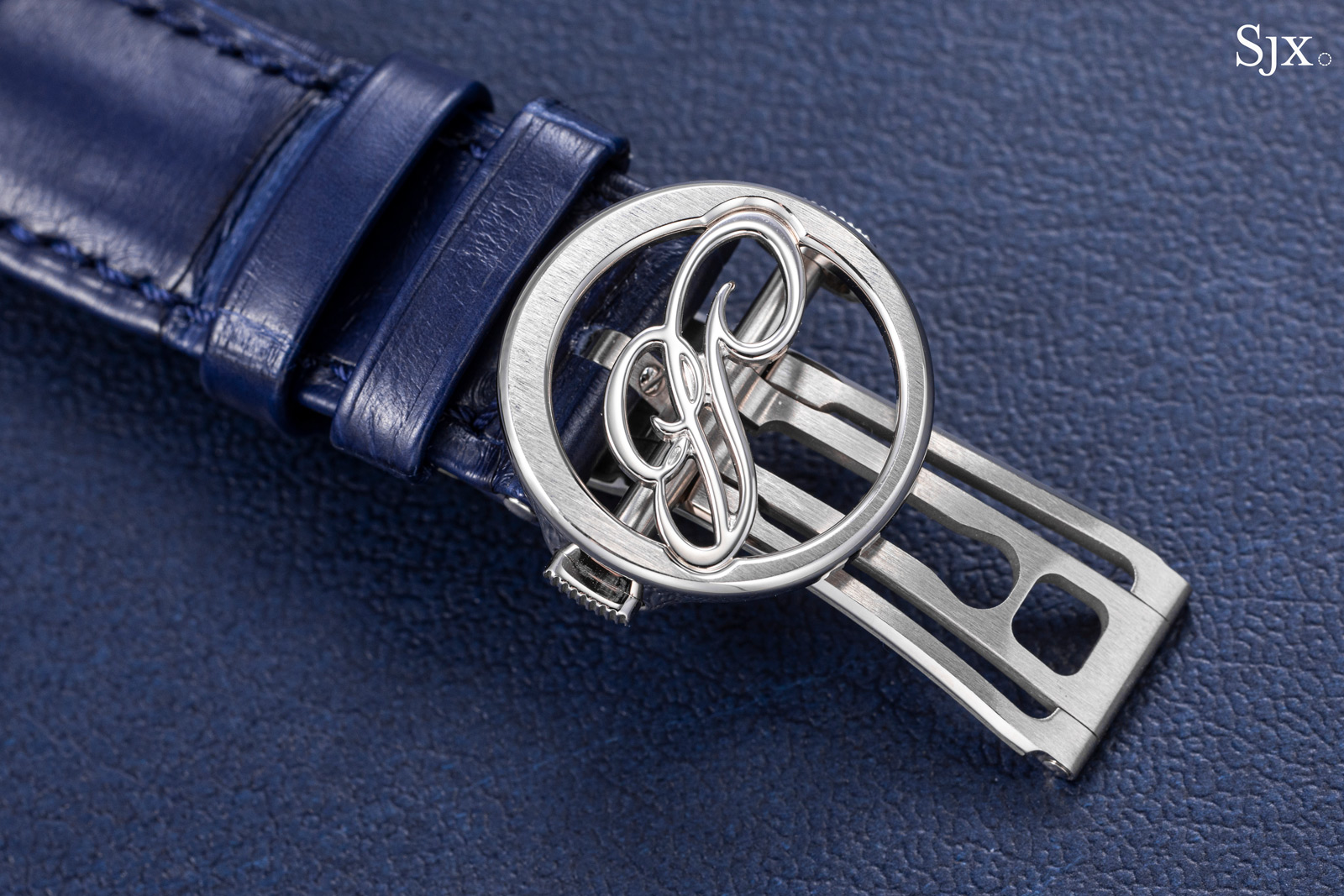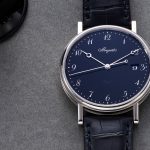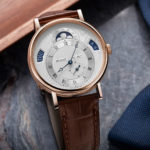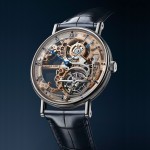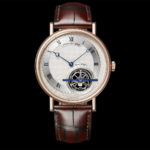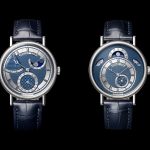Up Close: Breguet Classique Quantième Perpétuel 7327
Quintessential Breguet style, gently refined.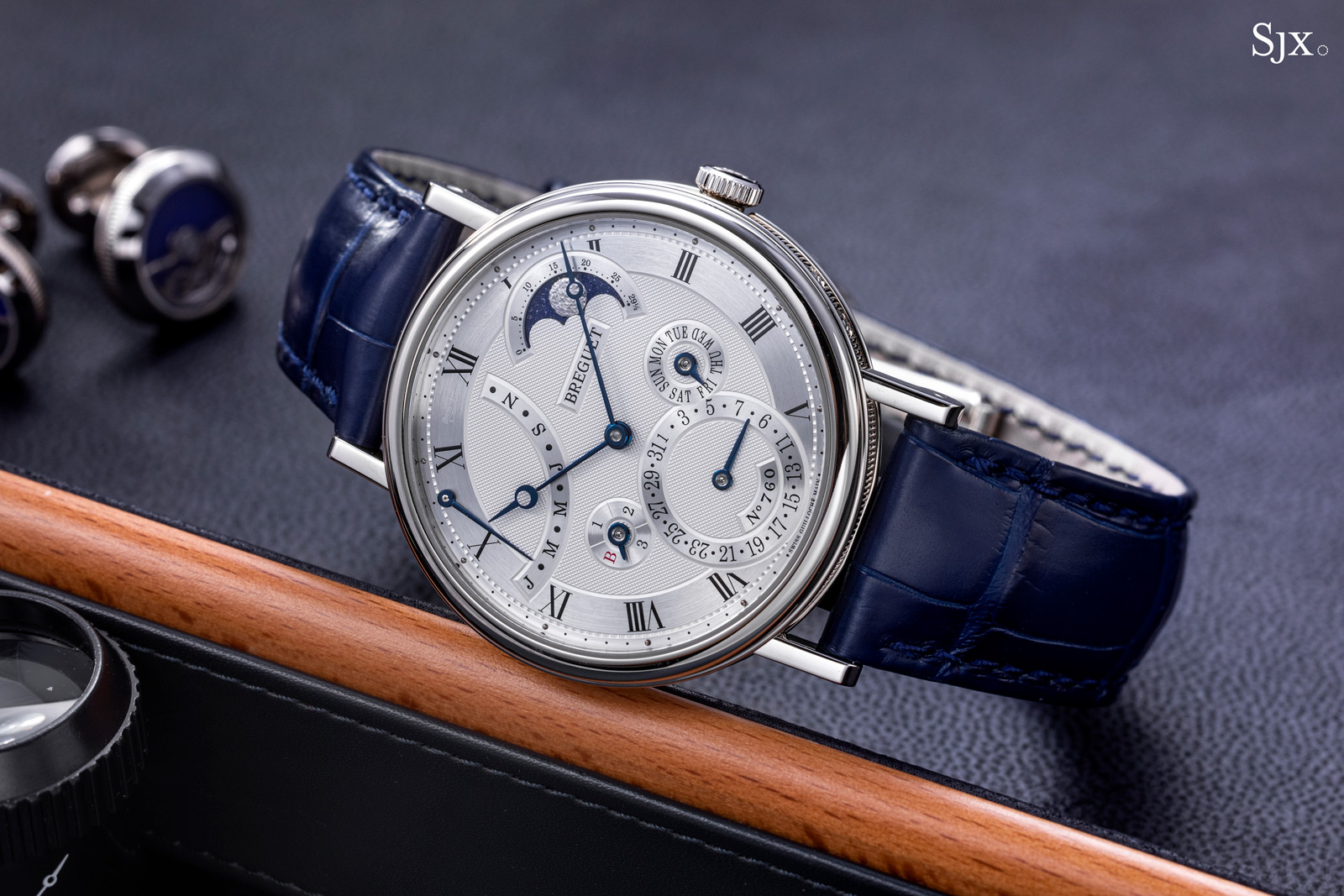
Breguet has announced a new flagship perpetual calendar wristwatch, the Classique Quantième Perpétuel 7327. Succeeding the ref. 5327 that’s been in the catalogue almost two decades, the new ref. 7327 retains the traditional style that defines the brand while incorporating refinements and gentle modernisation in the design. Importantly, the ref. 7327 features a new perpetual calendar mechanism that boasts an elaborate retrograde display that illustrates Breguet’s sophisticated approach to movement construction.
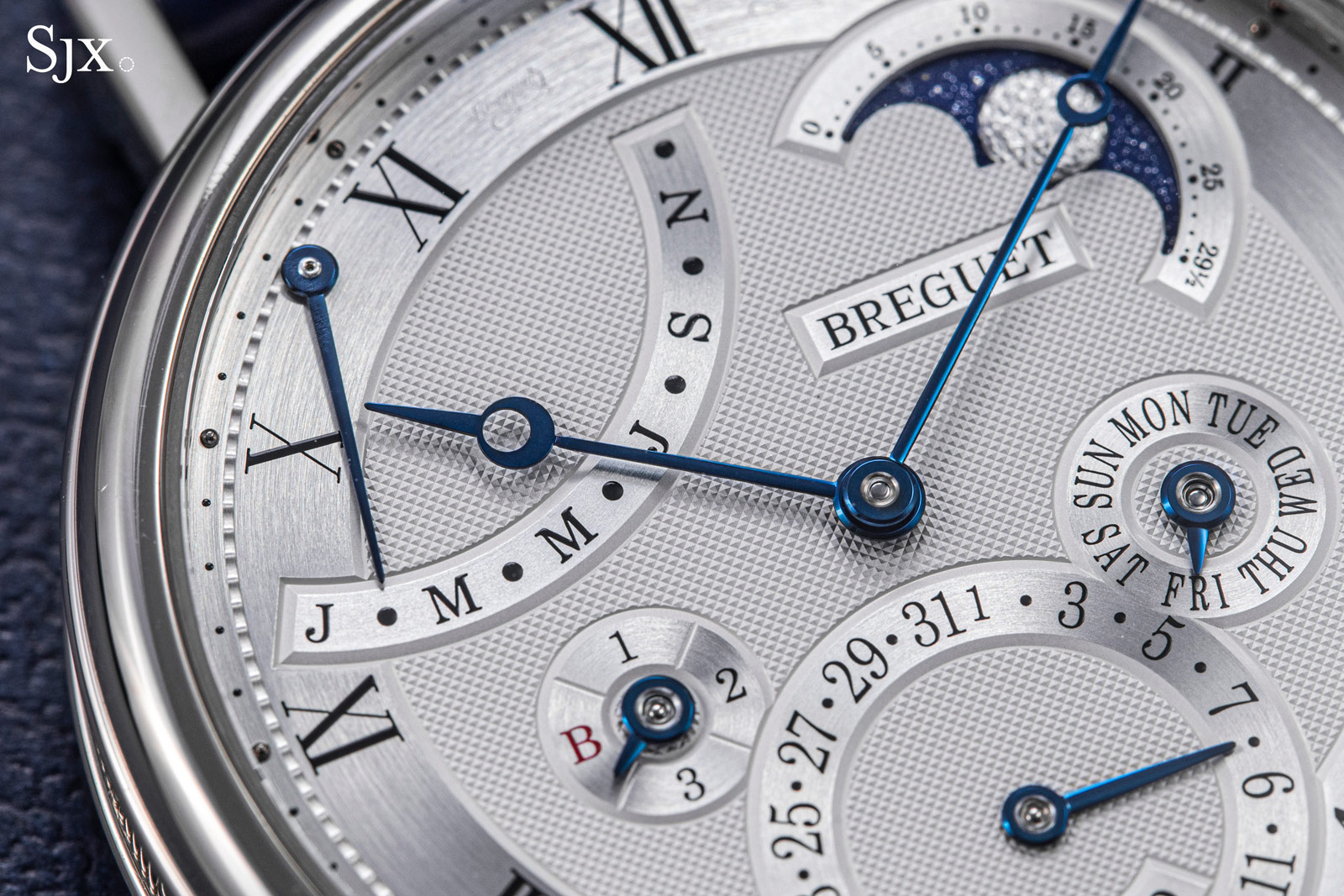
Initial thoughts
The design of the ref. 7327 is quintessential Breguet and indisputably the main attraction. The orderly yet asymmetrical dial finished in guilloche, pomme hands, and the slim case with a fluted band – it is Breguet.
Yet I’d be remiss not to mention the immense charm and finesse the ref. 7327 exudes. Thoughtfully executed dress watches are seldom encountered today, especially ones with svelte, just-right proportions, but this a niche that Breguet has mastered with consistency and quality.
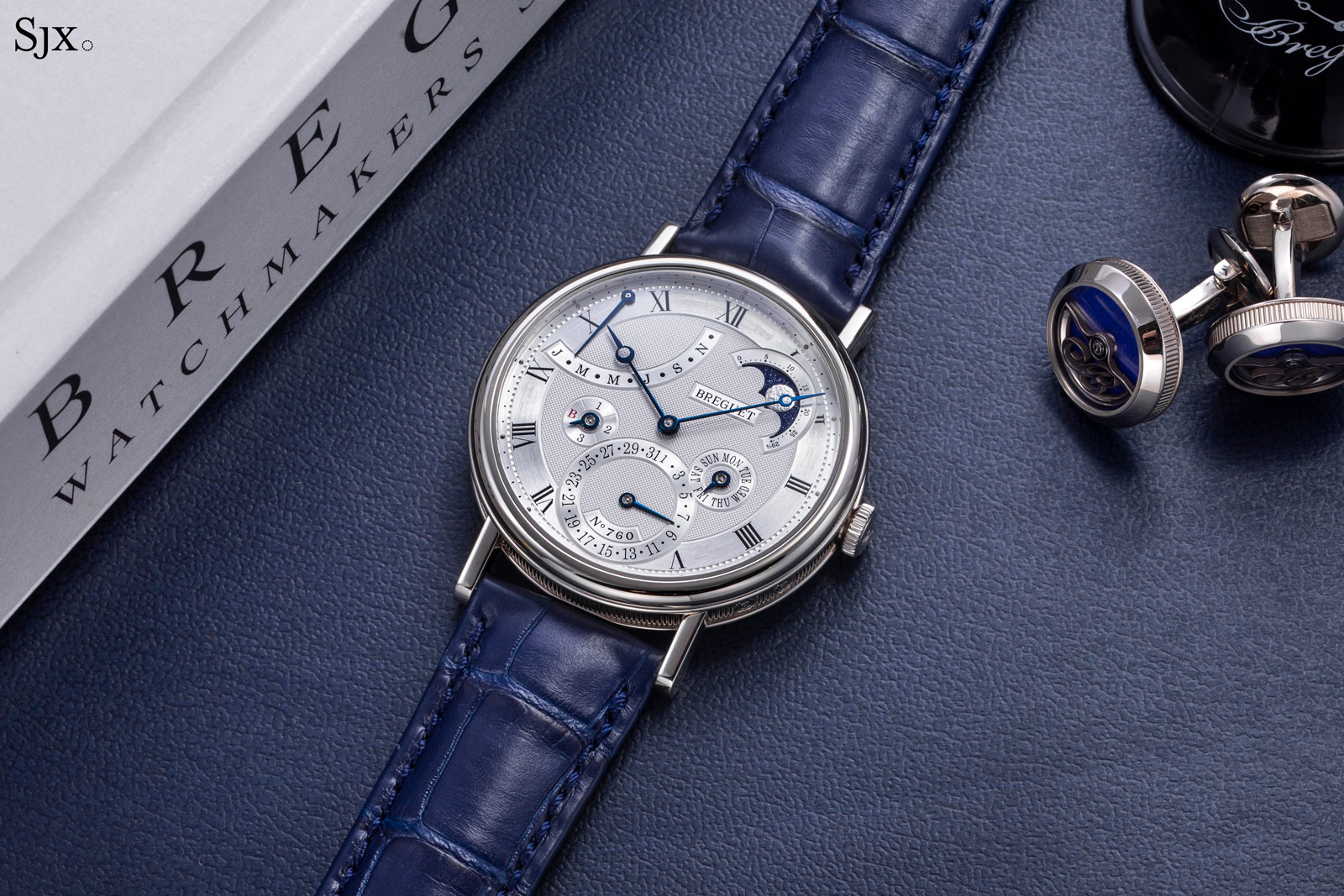
The design of the ref. 7327 is particularly interesting because it is clearly classic Breguet, but with a modern twist. The dial is slightly cleaner than old-school Breguet wristwatches, which were often elaborately, and sometimes fussily, decorated. But unlike the facelifted ref. 7337, for instance, which traditionalists might argue is too modern, the ref. 7327 is still eminently classical.
Additionally, the addition of a retrograde month display at 11 o’clock adds character to the dial in a typically Breguet fashion. It breaks up the symmetry in a pleasing manner, exactly as was done in Breguet’s 19th century pocket watches.
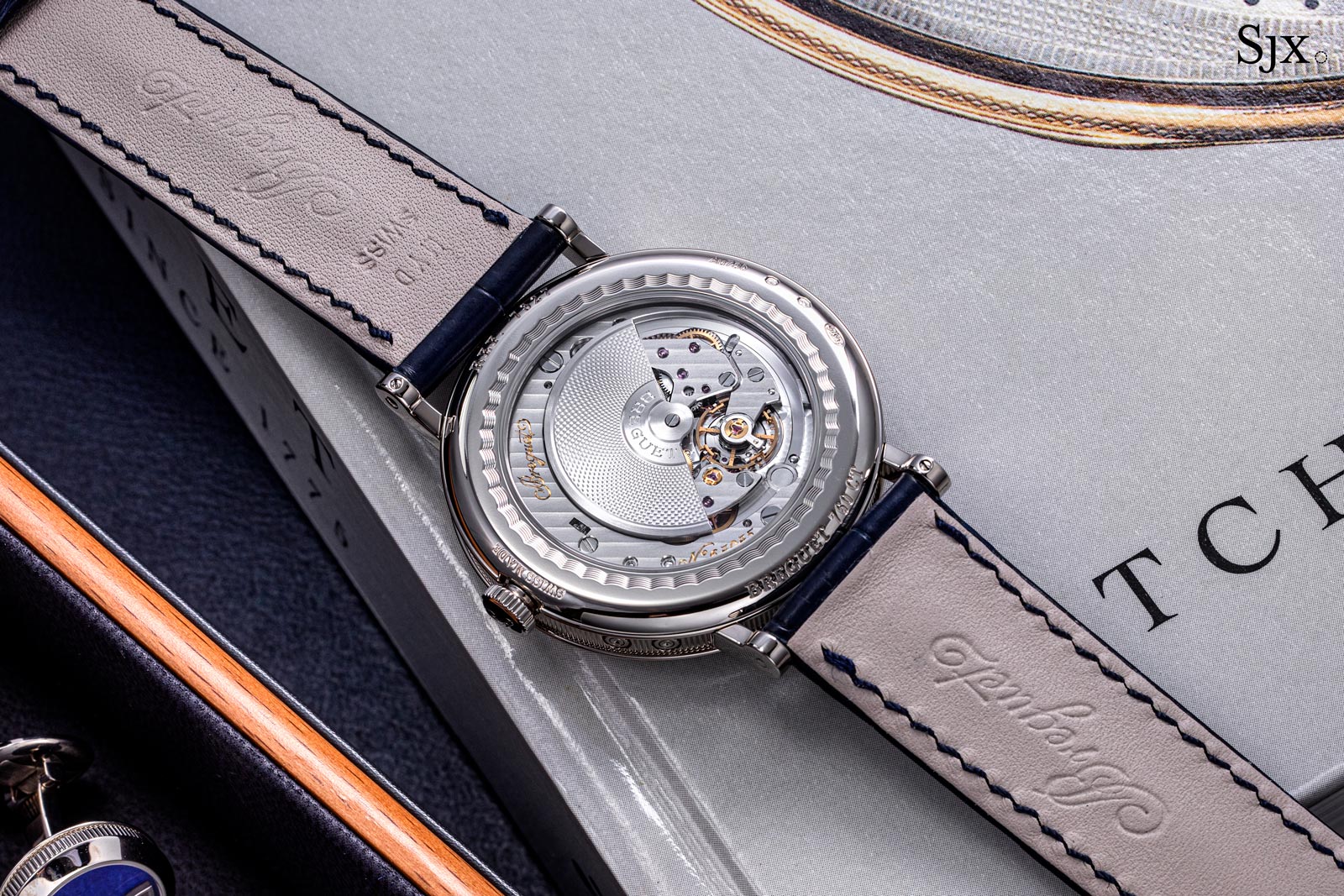
The base movement is the ultra-thin cal. 502 with its distinctive off-centre rotor
But in gaining a more contemporary feel, the ref. 7327 might have sacrificed a few details that were unusual and appealing. One example is the streamlined moon phase indicator that does away the charming cloud motif found on its predecessor. But as is often the case with design, it is a matter of balance. The fluffy clouds may be gone, and so is the smiling face on the moon found on the earlier model. It’s been replaced by a hammered moon that is both evocative and artisanal – I very much prefer this over the smiling face that I found overly whimsical.
Overall, the dial quality is undeniably improved. That is most apparent in the fineness of the hobnail, or clous de Paris, guilloche that has a much smaller grain than on the outgoing ref. 5327. The hobnail pattern is now fine enough to be found within the day-of-the-week indicator.
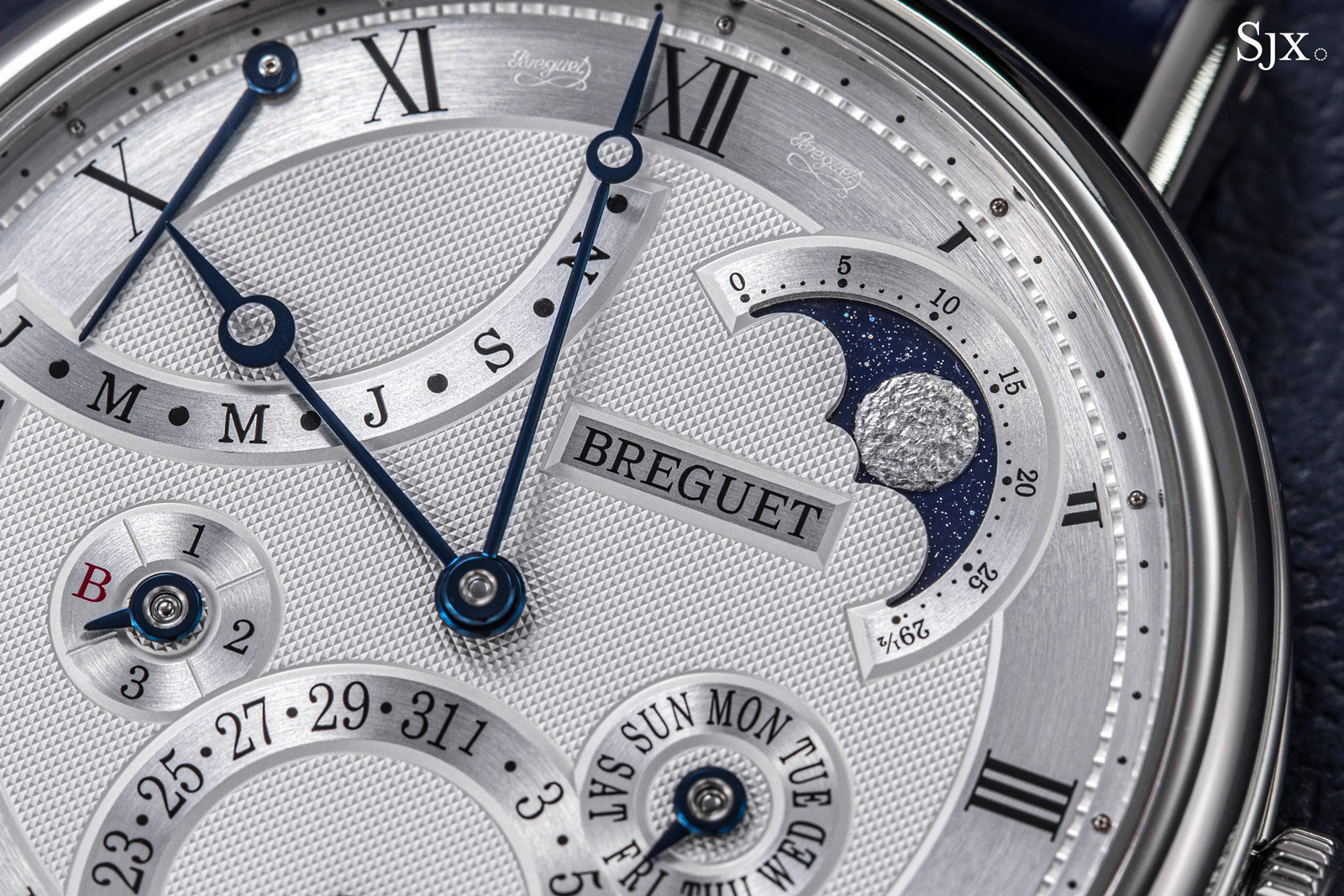
The hobnail dial and hand-hammered moon
Priced at CHF78,300 in either rose or white gold, the ref. 7327 is arguably well-priced within the segment of high-end perpetual calendar watches when compared against its predecessor as well as the competition. It’s priced almost identically to its predecessor (the increase is under 9%) and is even more competitive against the competition, namely similar offerings Patek Philippe and Vacheron Constantin. The comparable are between 10-20% pricier but lack the added value of the solid-gold guilloche dial and finely constructed case.
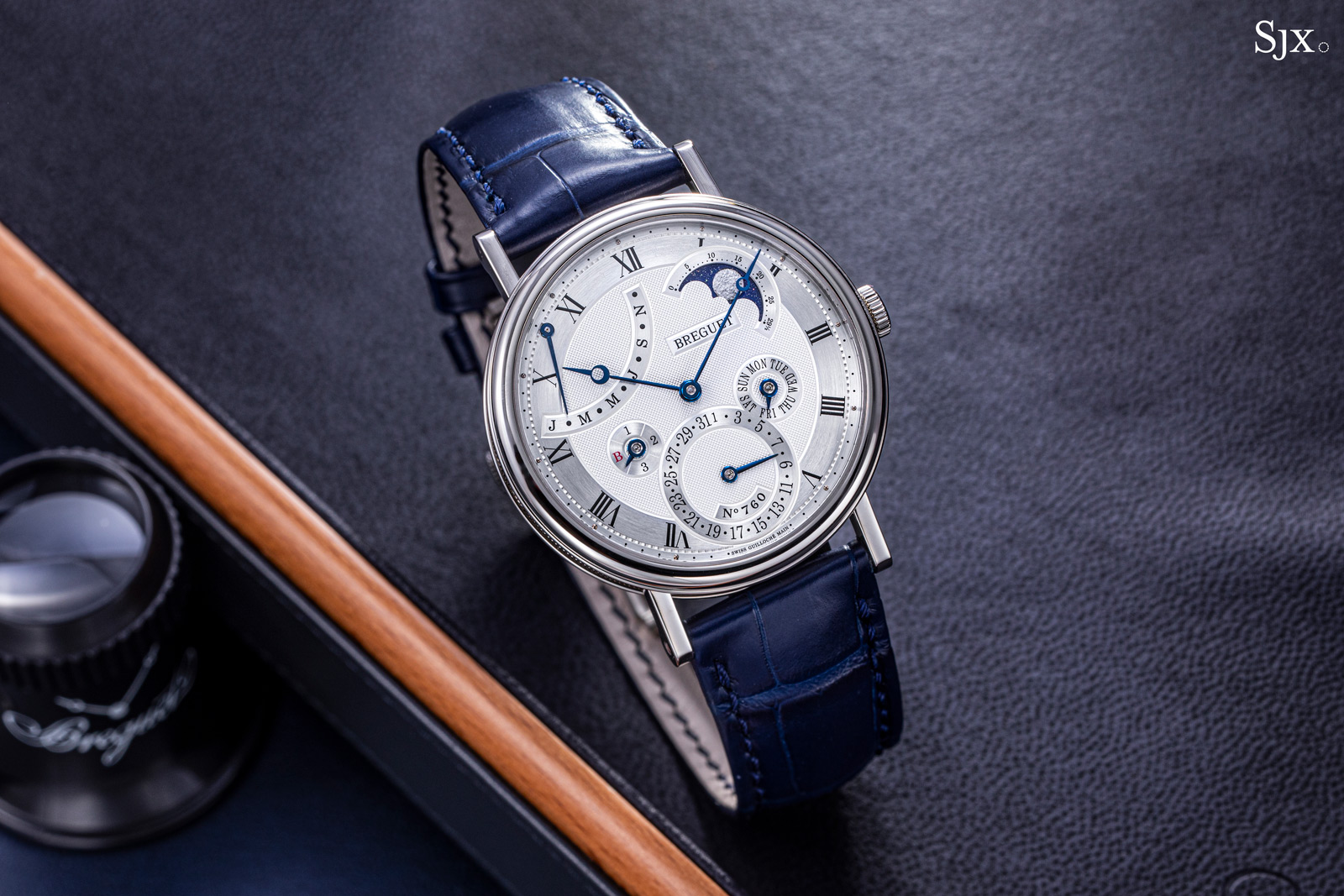
Rooted in heritage
Traditional in its styling, the ref. 7327 continues Breguet’s longstanding practice of taking inspiration of its pocket watches from the 18th and 19th centuries to create classically-designed wristwatches. It’s is part of the Classique collection, the brand’s anchor collection of watches that ranges from entry-level time-only models to highly complicated watches like the ref. 7327. Despite the diversity in the collection, the range shares the common them of Breguet’s expertise in marrying the traditional, most notably with guilloche, and the modern, exemplified by its use of silicon components in movements.
Like the other watches in the Classique range, the ref. 7327 takes its cues from earlier perpetual calendars, the refs. 3310 and 5327, which in turn were modelled on pocket watches. Introduced in the mid 1980s, the ref. 3310 was one of the most complex perpetual calendars Breguet offered at the time, including individual displays for the day, date, month, and leap year, along with a moon phase and power reserve indicator.
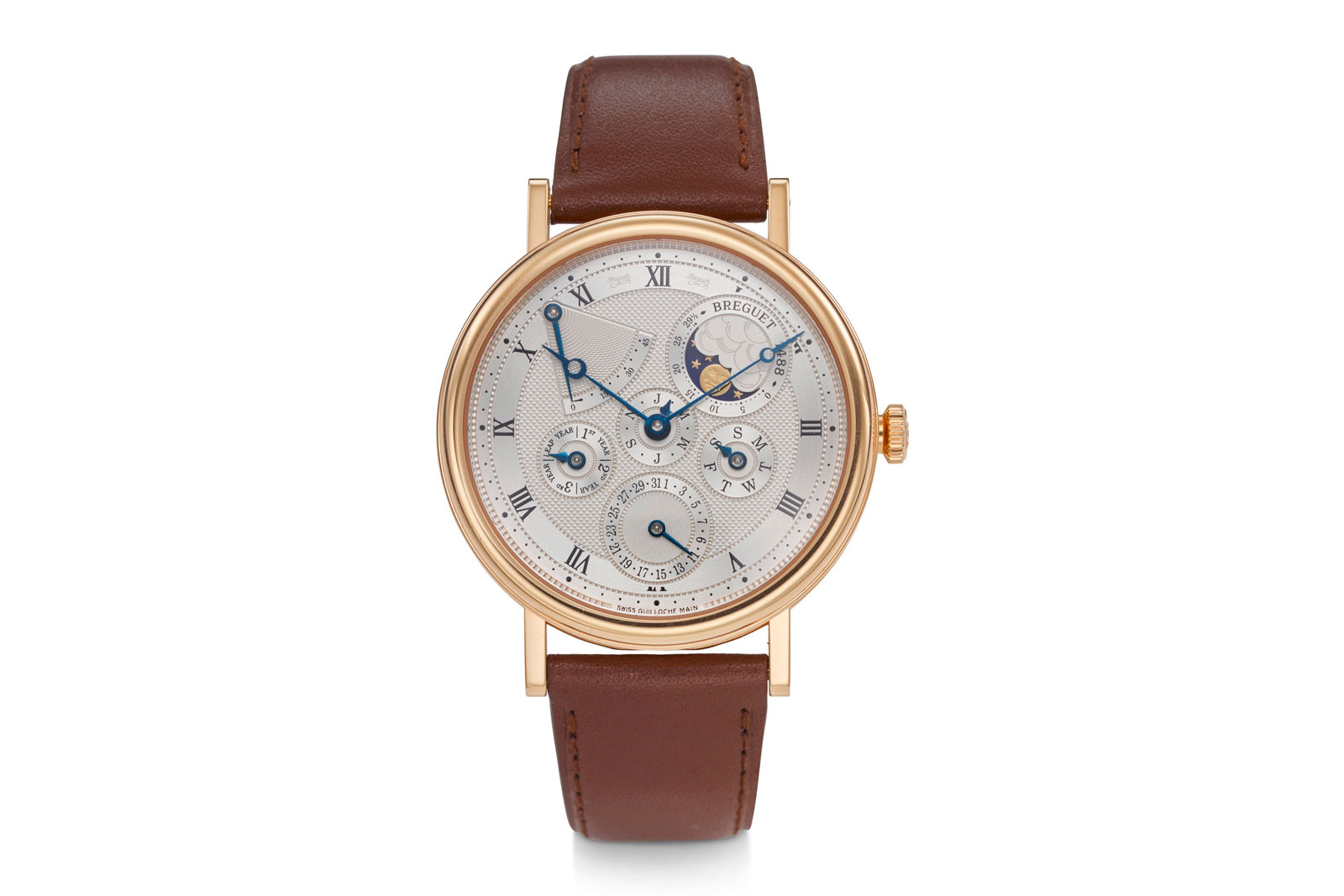
An example of the ref. 5327 in rose gold. Image – Christie’s
In 2004, Breguet introduced the updated version of the ref. 3310 in the form of the ref. 5327. The ref. 5327 retained the same dial layout and movement, but had a more contemporary case size of 39 mm (instead of the ref. 3310’s 36 mm). While similar in design, the larger size allowed for a wider dial and slightly better legibility. The ref. 5327 also gained in practicality: it employed a date corrector that made setting the calendar more straightforward. And a sapphire case back was added to showcase the finely decorated movement.
As a direct successor in this lineage, the ref. 7327 continues down the same path of discreet refinements while preserving the signature style. It continues with the 39 mm case while gaining a more legible and modern dial.
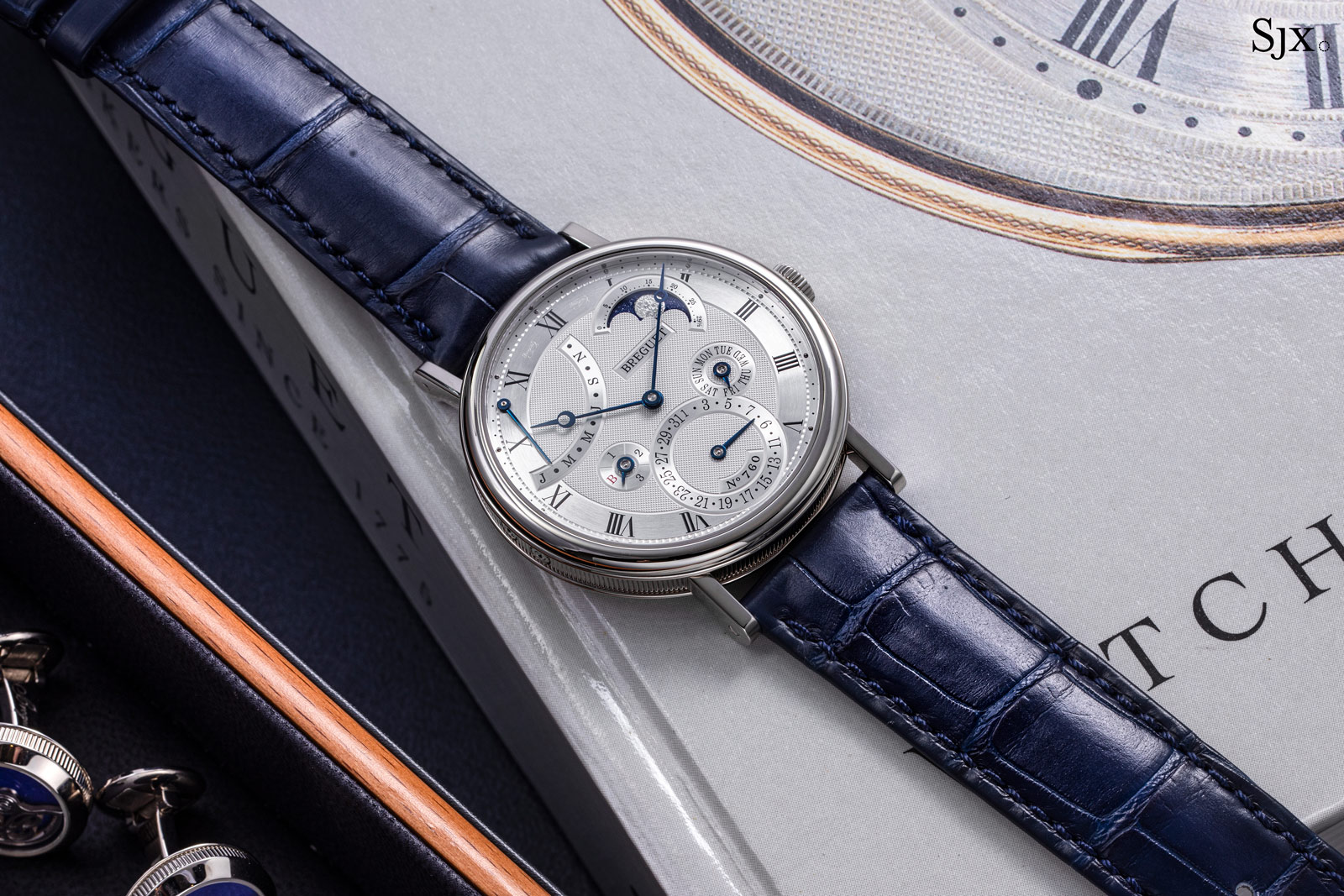
Gently streamlined Breguet style
Both the refs. 3310 and 5327 were relatively busy looking as a result of squeezing several indicators onto the dial. The busy, ornate look was typical of Breguet at the time but not especially practical in terms of readability.
In contrast, the ref. 7327 has a visual lightness thanks to streamlined design. It does that by both adjusting the details of the dial as well as the complication itself.
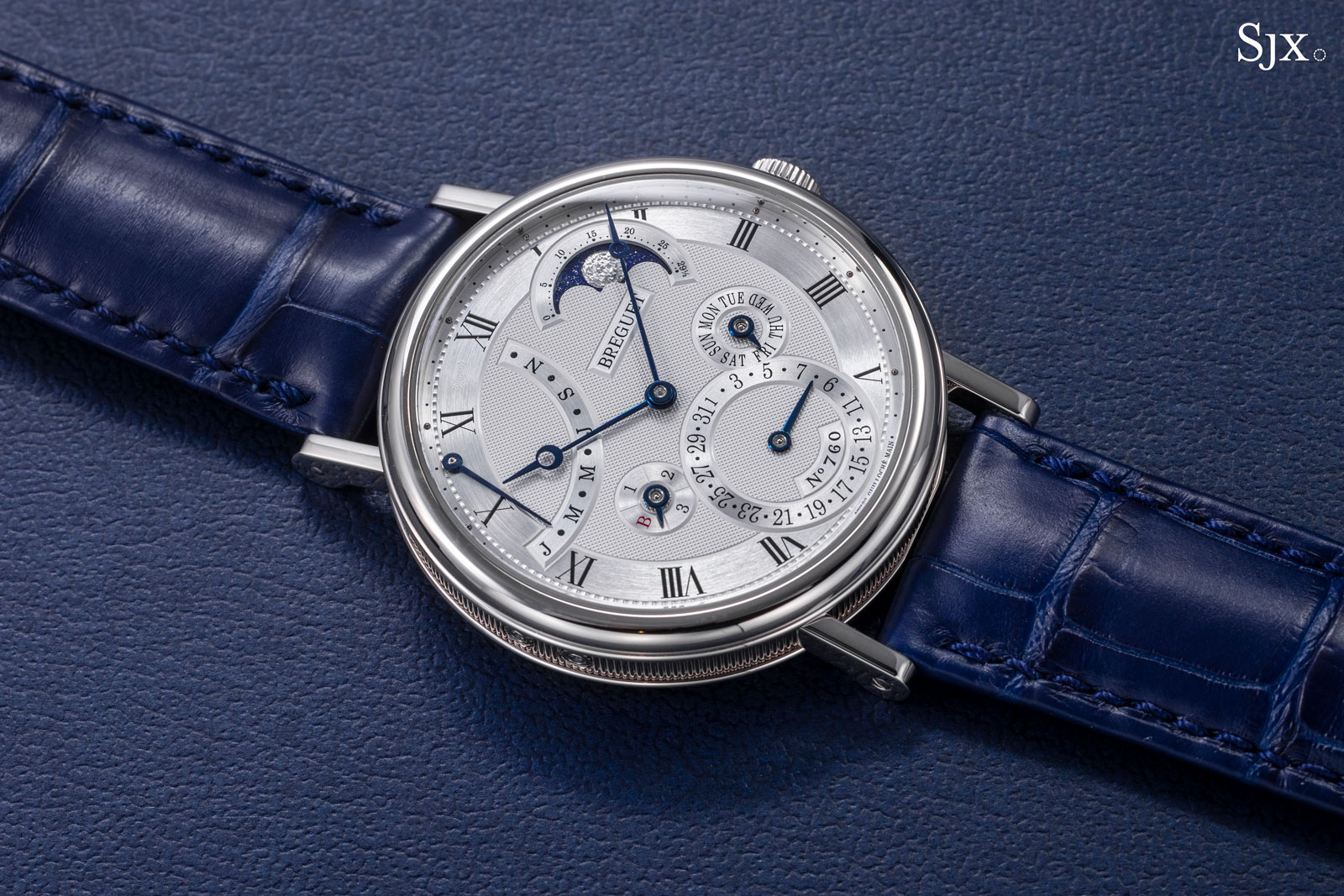
Previously a power reserve indicator, the fan-shaped scale between ten and 11 o’clock is now the months display. Now wider than before, it spans nine to 12 o’clock, making it both a design element and an improvement in legibility when compared to the tiny pointer around the hour and minute hands in the earlier models.
Another logical tweak to the dial is the enlarged date indicator at six o’clock. Besides being easier to read, it gives the dial better vertical balance. The large date register also means the day and leap year indicators seem relatively smaller, reducing the clutter on the dial.
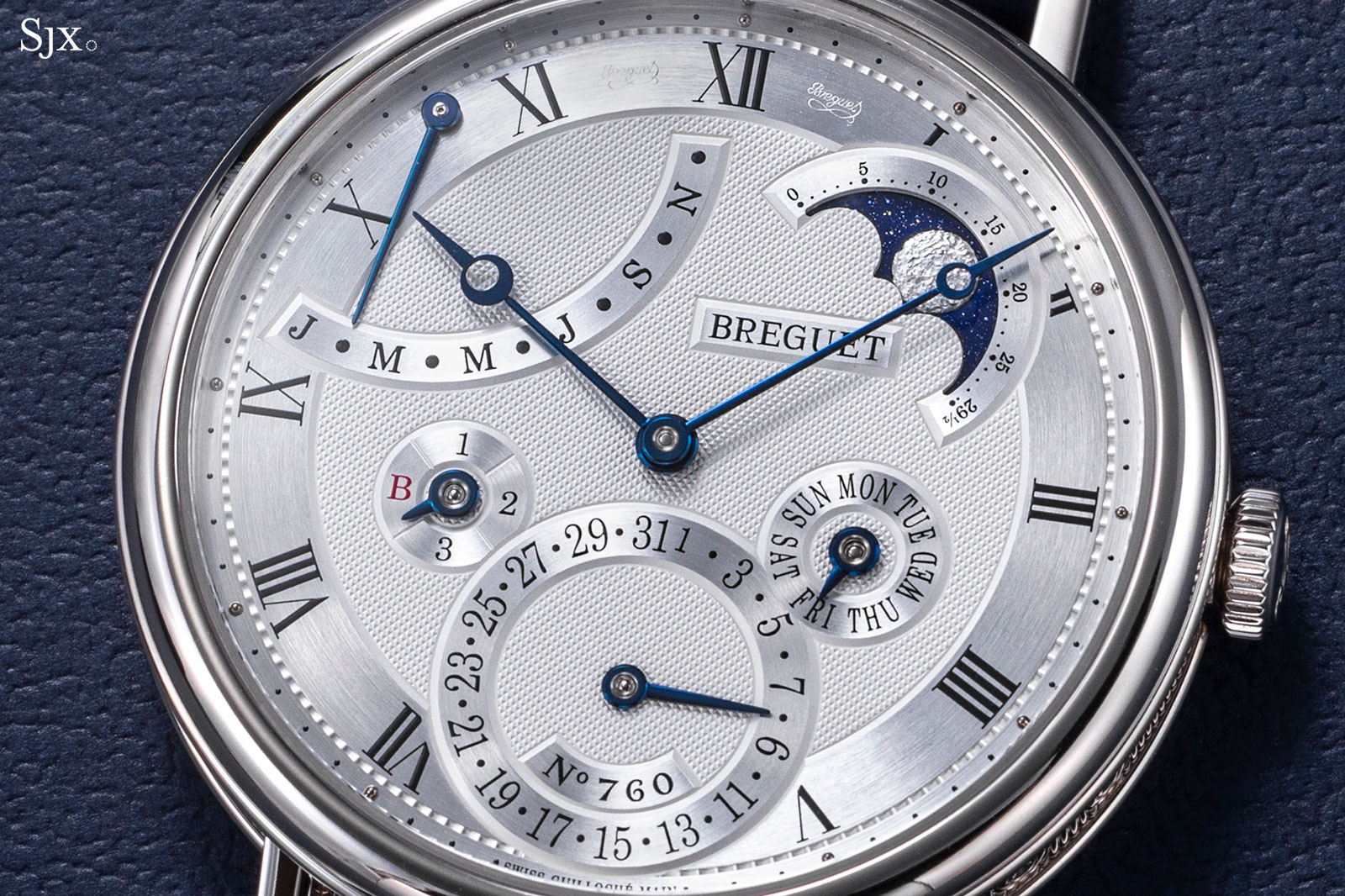
Like all of Breguet’s guilloche dials, the dial in the ref. 7327 is a solid gold disc finished with intricate guilloche engraved by hand-operated rose and straight-line engines. Breguet excels at high-quality guilloche dials at scale – according to industry insiders the company is amongst the biggest owners of traditional engine-turning machines in Switzerland.
While Breguet historically employed several types of guilloche on a single dial, the ref. 7327 is finished entirely in clous de Paris. According to the brand, the choice of only clous de Paris is a return to the original specifications that A.-L. Breguet himself applied to his dials in the 18th century. On the other hand, earlier iterations of the model featured three styles of guilloche on the dial.
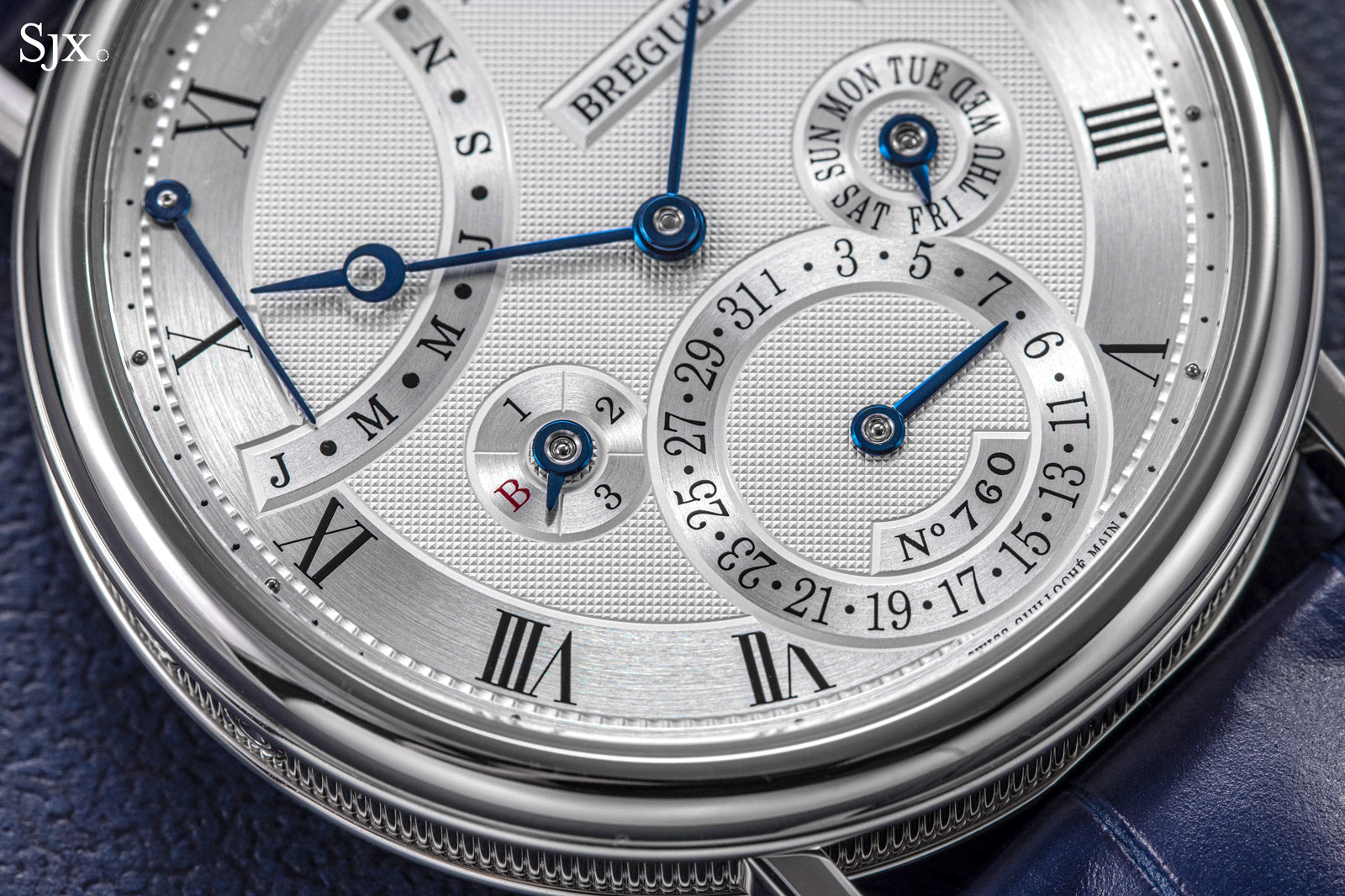
Even though the dial relies on just a single type of engine turning, it is evidently finer up close as the hobnail pattern on a much smaller scale. The individual squares of the pattern are tiny, being essentially the same as as the serifs on the date numerals.
The fineness of the guilloche results in a subtle but important change to the borders of the registers and indicators. Unlike earlier versions of the model, the ref. 7327 does not feature fluted borders around the displays that is traditional for guilloche. The intricate fluted borders contribute to the fussy appearance of the earlier models; conversely, the clean borders of the ref. 7327 are a key element in the cleaner, modern appearance.
While some might frown at the disappearance of the fluted borders, they were historically used as camouflage to obscure the uneven edges of the guilloche. Here they are no longer necessary due to the high degree of accuracy in cutting the hobnail pattern.
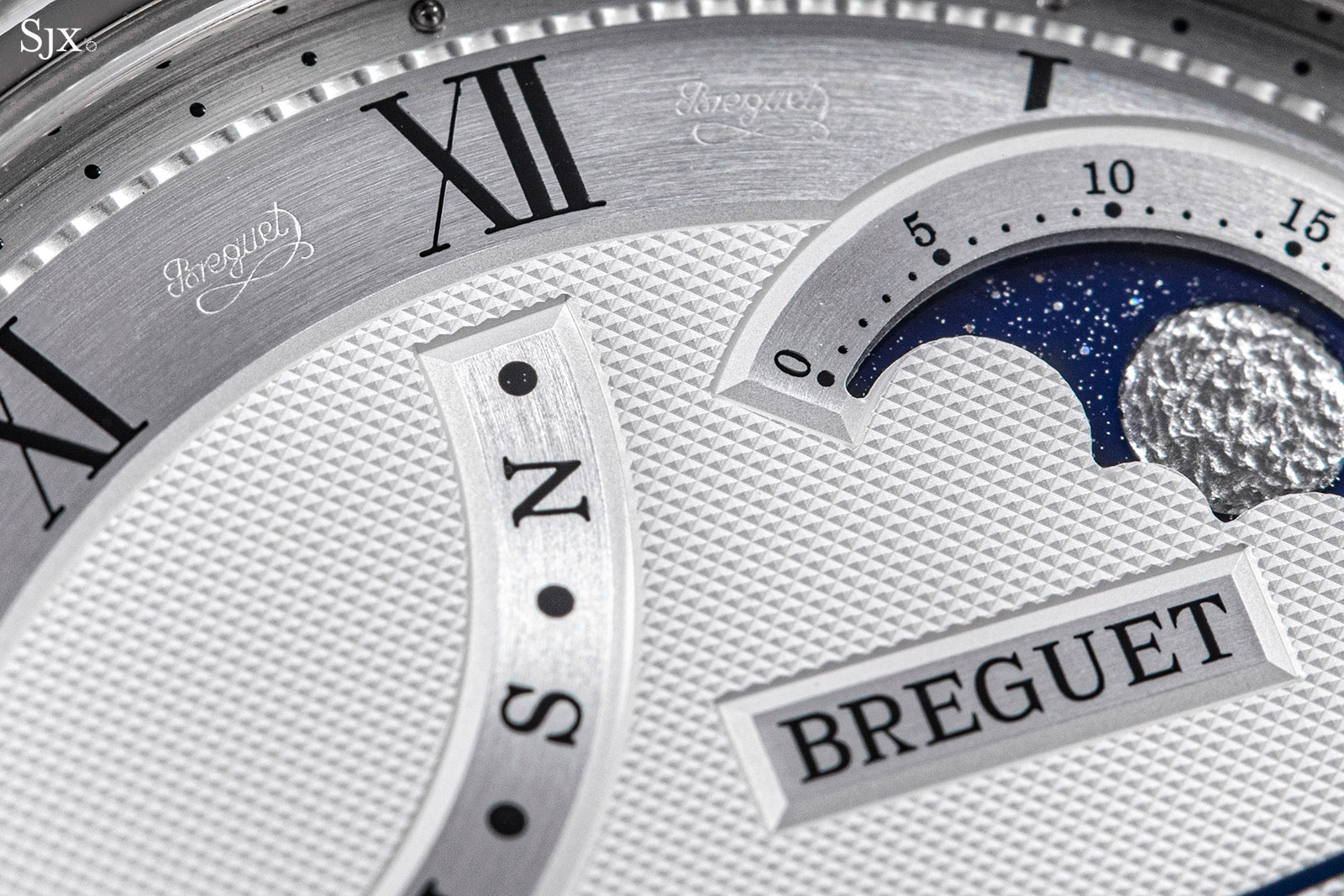
Each indication is framed by a clean border
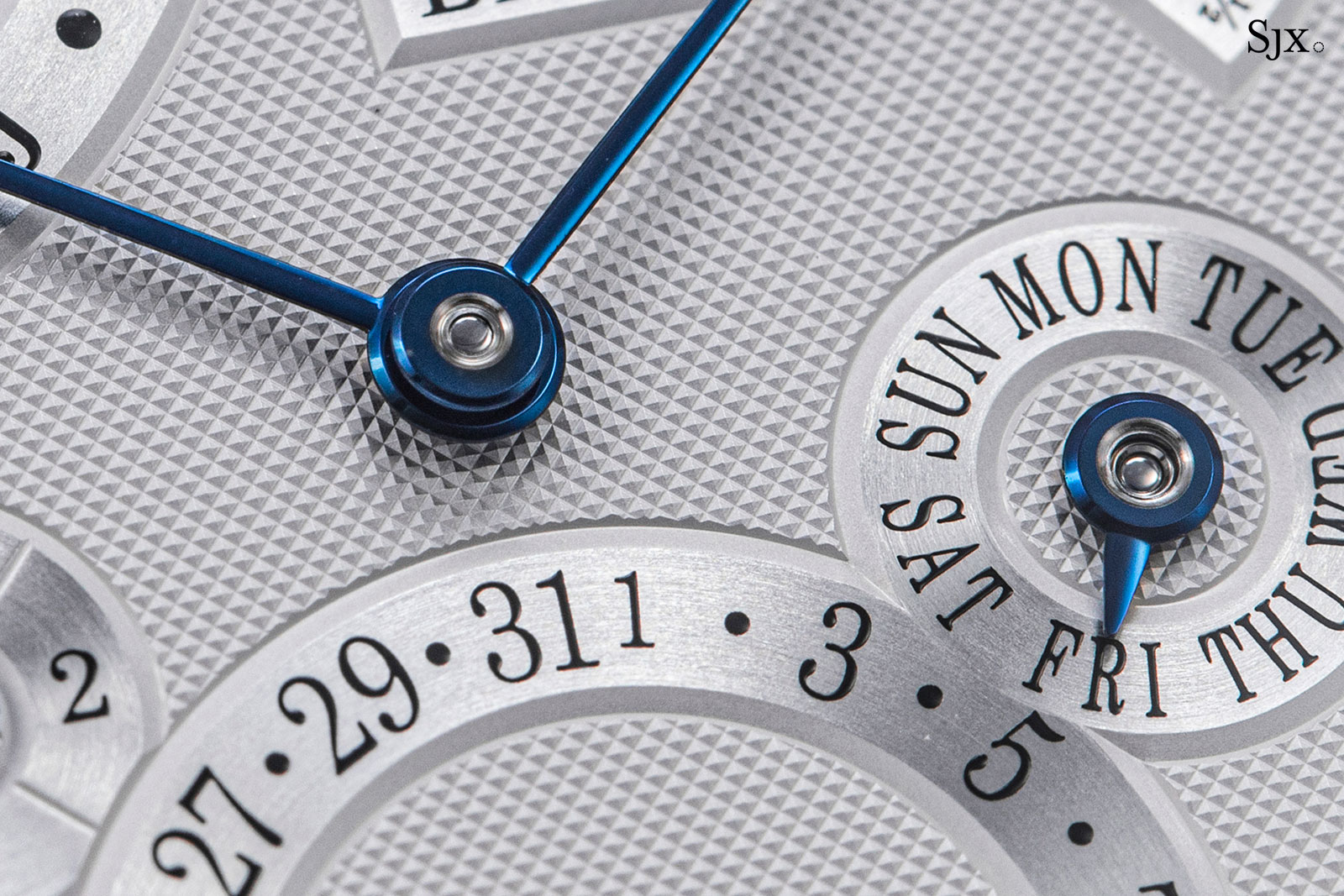
The impressively fine hobnail
Another substantial update to the dial can be found in the moon phase. It’s been scaled up to create a large display that contains a lacquered disc sprinkled with aluminium and silicon oxide particles that give it a sparkly finish evoking the night sky. On the disc sit a moon made of solid white gold that’s been delicately hammered to create an impression of the pockmarked lunar surface.
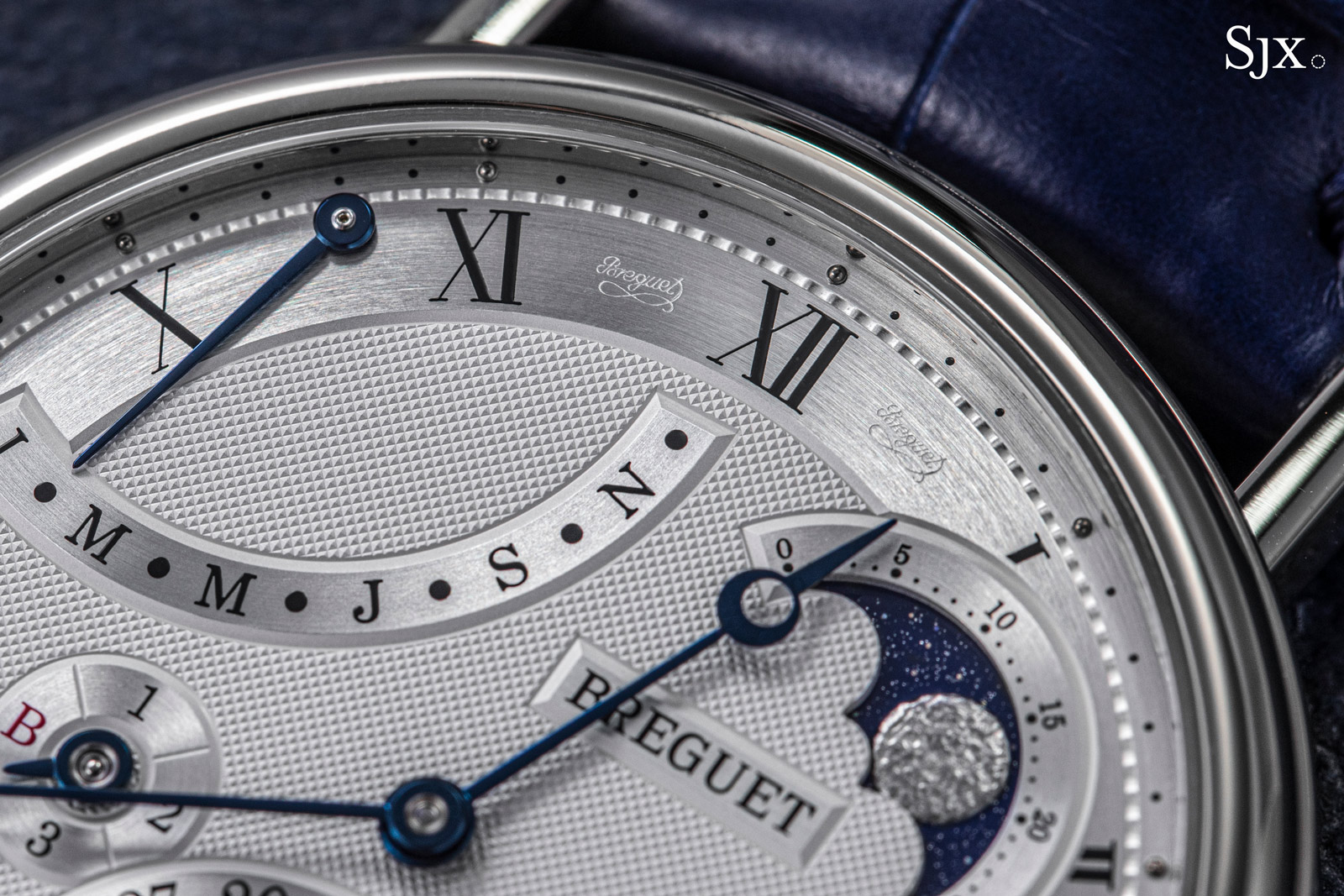
A pair of Breguet secret signatures engraved next to the XII numeral.
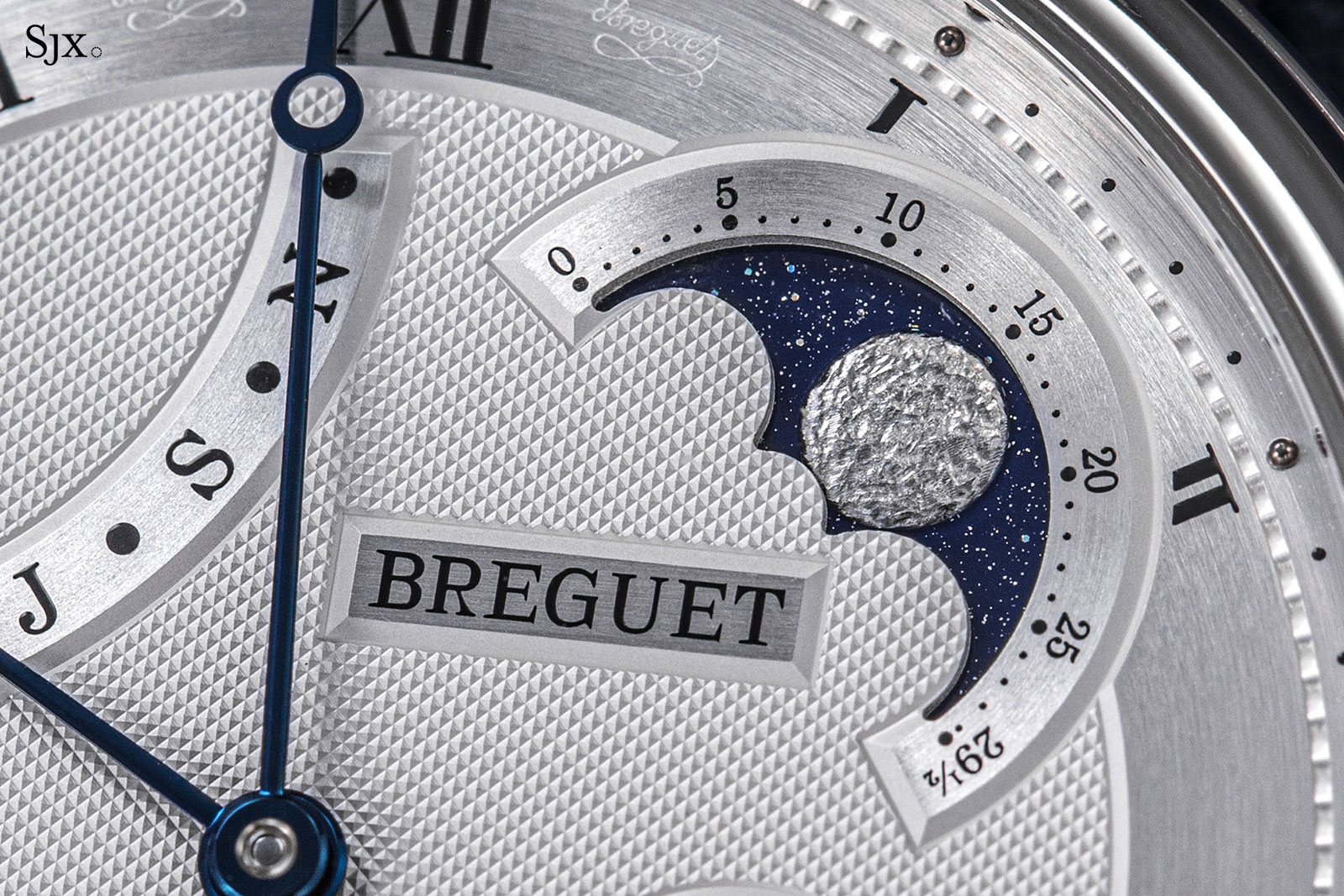
The dimpled moon
In terms of style, the case is classic Breguet. It has narrow, straight lugs that are soldered to the case by hand, and reeded case band. The result is a formal, elegant watch.
The case of the ref. 7327 remains relatively similar in size the preceding ref. 5327. Available in white or rose gold, the case is 39 mm in diameter and 9.13 mm high, making it 0.08 mm taller than its predecessor (a consequence of the revised perpetual calendar mechanism), but still notably thin considering its diameter.
Being wide and slim, the case has the elegant proportions that define many of Breguet’s watches. The narrow bezel and long lugs mean the watch feels a little larger than 39 mm, but that doesn’t detract from the elegant profile.
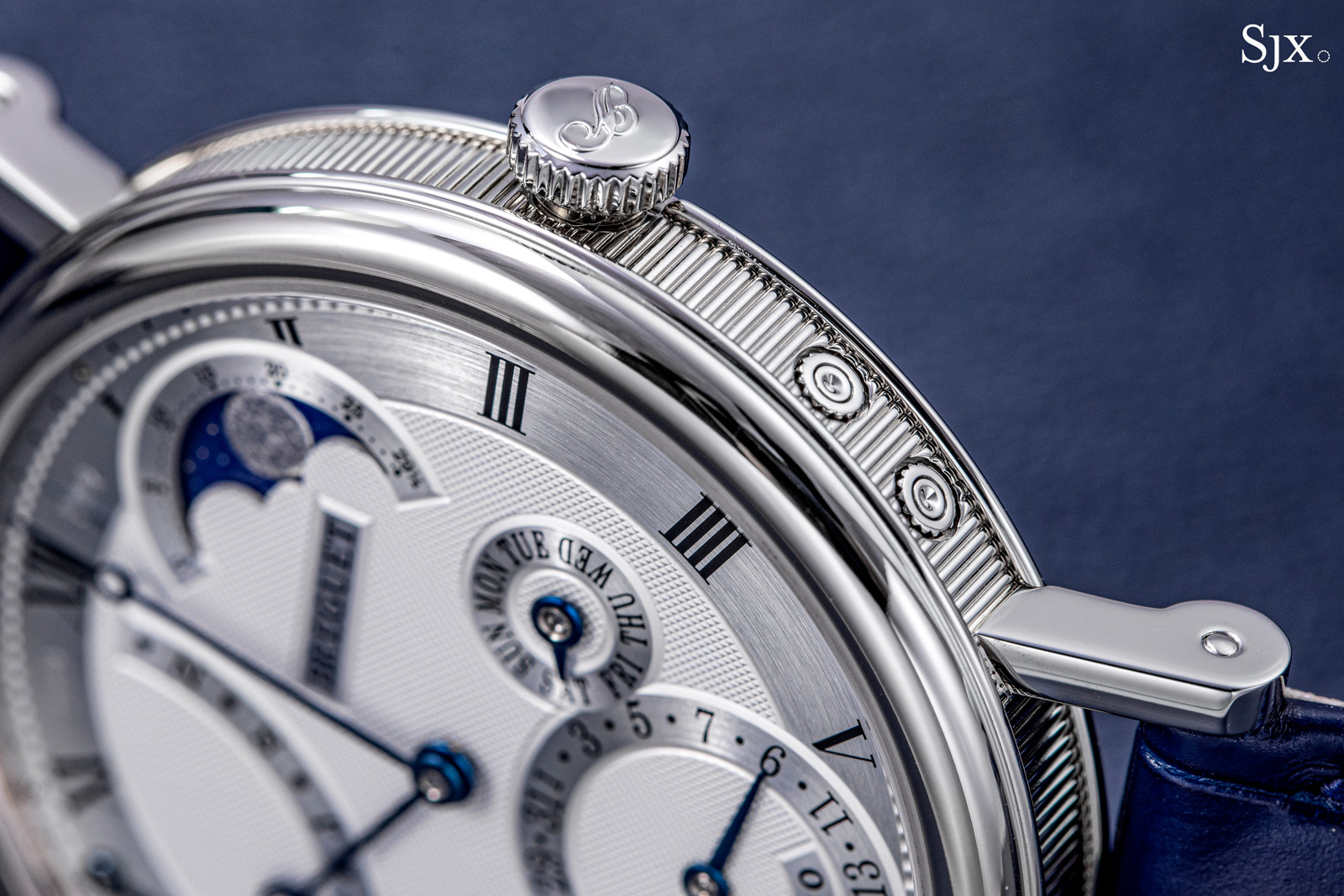
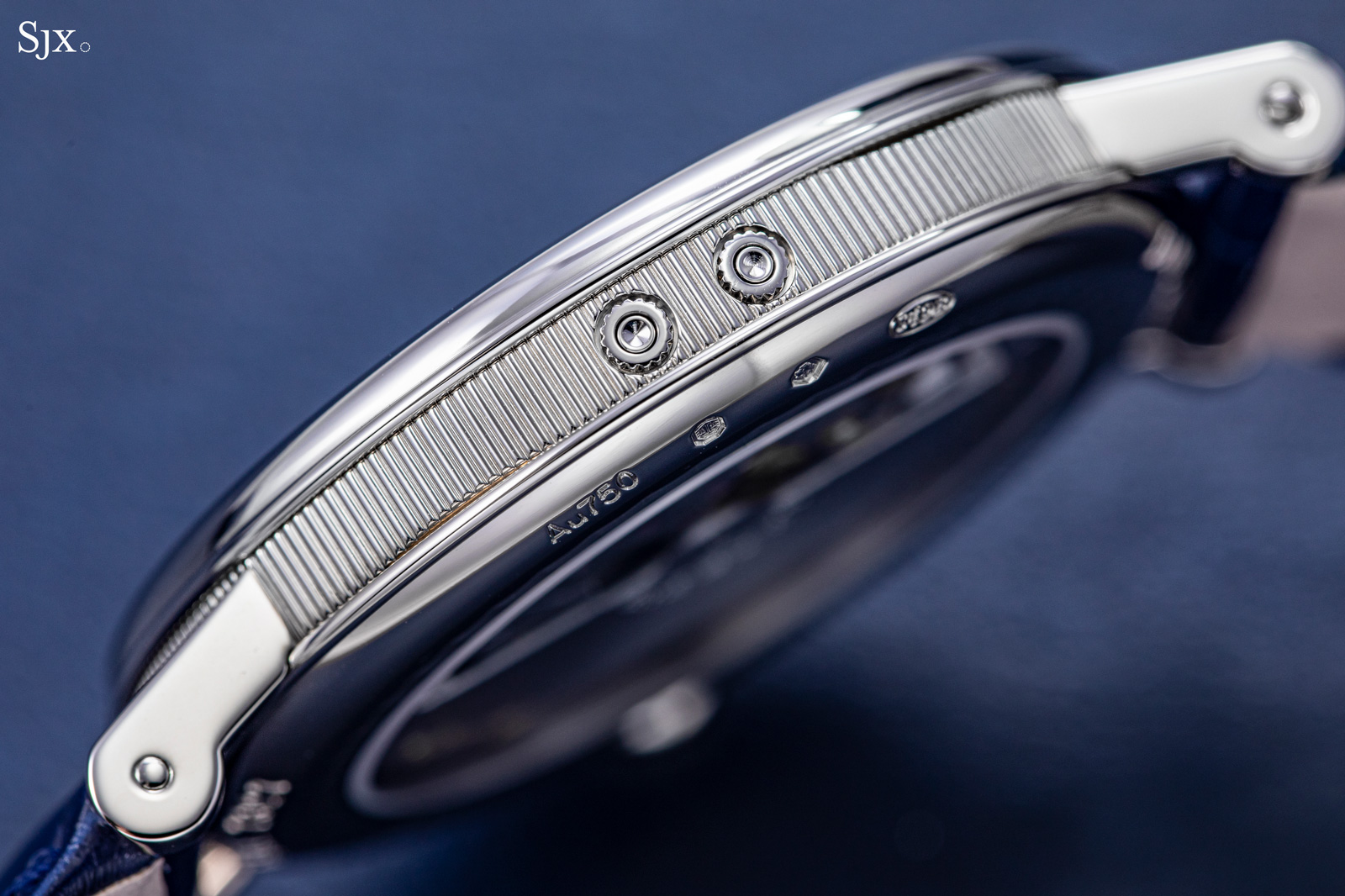
A distinguishing feature of the Breguet watch case
Though often overlooked, the folding clasp deserves a mention due to its surprisingly fine finishing. It is quite large and perhaps a bit too chunky for such an elegant watch, but lightweight and practical as the blades of the clasp are skeletonised.
The open working of the buckle creates many exposed edges, yet all of the edges are polished with an impressive consistency. The polished edges contrast against the brushed finish of the top surfaces, bringing to mind a finely decorated movement.
Classical modular
While the dial has been substantially redesigned, the mechanics within are familiar. The ref. 7327 is powered by the cal. 502.3.P – a venerable, ultra-thin automatic movement combined with a variant of an existing perpetual calendar module.
The roots of the perpetual calendar are easily recognisable as the basic architecture of the module can be found in virtually every Breguet perpetual calendar. The closest mechanical relative of the calendar mechanism in the ref. 7327 is that found in the ref. 5447 of 2007, which has an identical dial layout but with a minute repeating base movement. Naturally, the bulkier repeating movement of the ref. 5447 necessitated a larger case of 40mm wide and a significantly thicker 15.22 mm height.
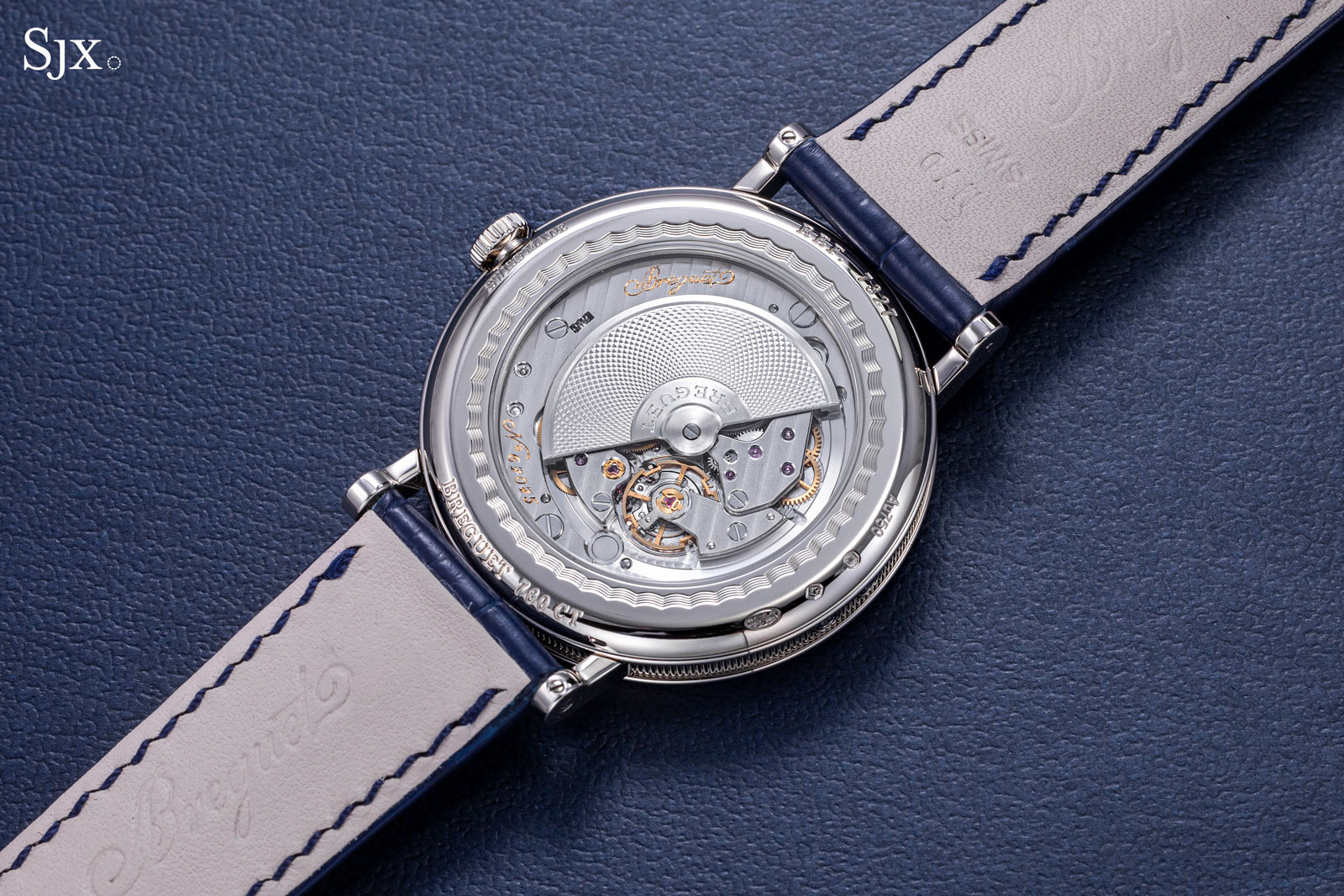
The cal. 502.3.P
In fact, the architecture of the perpetual calendar module, sans retrograde, can be traced to 2004 when it made its debut in the ref. 5327. The display of the ref. 5327 was arguably cluttered, particular with the month indicator located at the dial’s centre and a power reserve indicator at 11 o’clock. The ref. 7327 streamlines the layout by revamping the calendar module to forgo the power reserve indicator in favour of a retrograde month indicator.
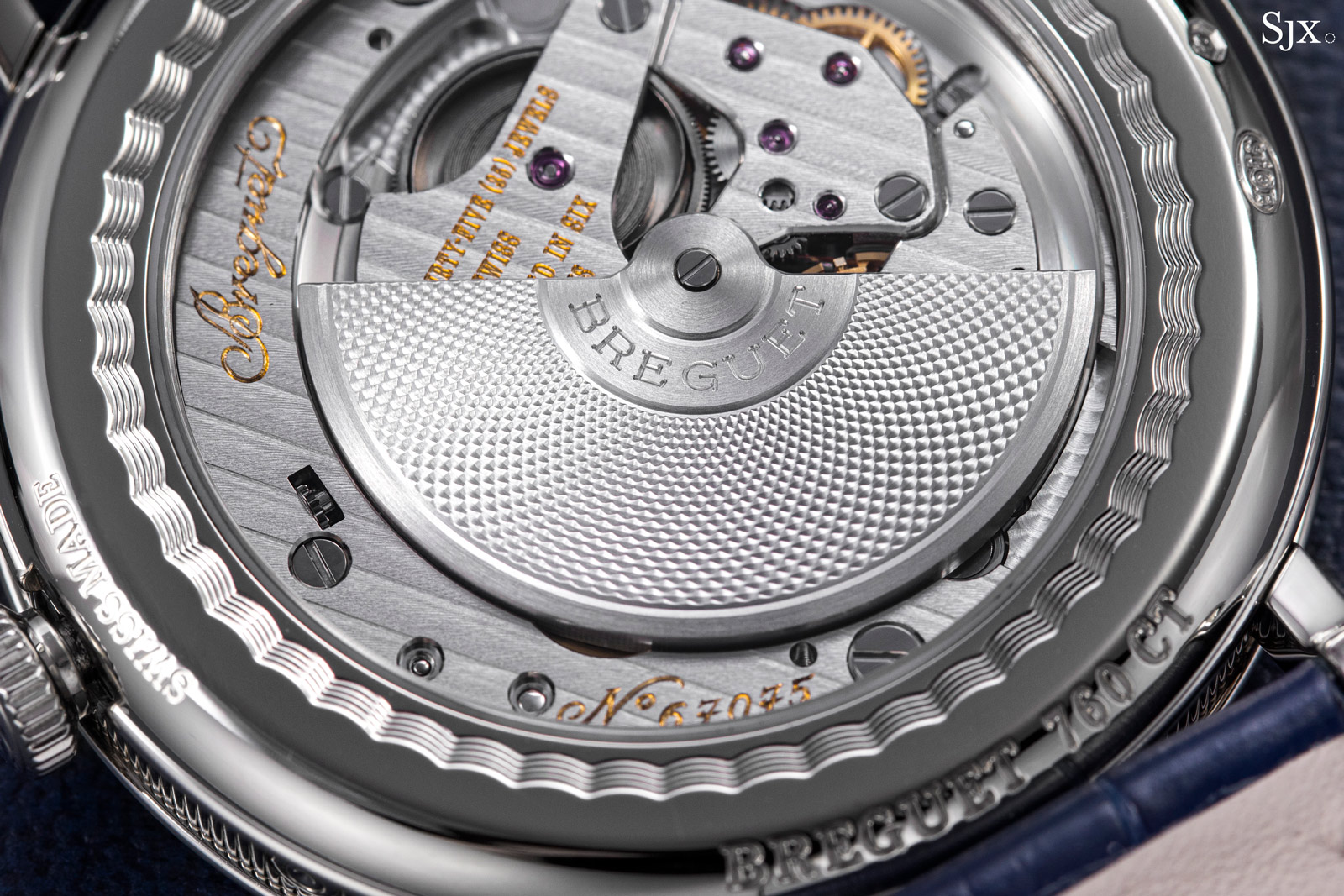
Despite the optimisation, the perpetual calendar mechanism is fundamentally a classical construction that uses a traditional, “grand lever” mechanism. In such a mechanism, the “grand lever” rotates a different distance based on the length of the month, which is encoded in an aptly named 48-tooth wheel that encodes the 48 months over a four-year cycle.
This approach is as traditional and straightforward as a perpetual calendar can be, so it doesn’t include the convenient quickset ability of more modern constructions. As a result, adjusting the calendar has to be done via the pushers embedded in the case band.
That said, the perpetual calendar is not entirely traditional. It has a fanciful display for the month thanks to an interesting retrograde mechanism that deserves a closer look.
A retrograde study
The retrograde month mechanism makes for an interesting case study in the constraints when designing a dial layout and the corresponding mechanical implications below the dial.
Mechanically, a retrograde mechanism is simple to understand at its core. A retrograde lever, or rack, has a tail end that physically contacts a cam which is often shaped as a snail. As the cam rotates, its shape dictates the angular position of the retrograde lever that is pressed against it.
Illustrated in the diagram below, the retrograde mechanism in the ref. 7327 has a retrograde lever to mechanically “read” the months via a month cam. The month cam has four curved arms, and is mounted on the 48-wheel which makes one revolution every four years corresponding to a complete leap year cycle. The sharp, vertical “drop” of the cam’s arms represent the transition from the December to January when the retrograde display resets by jumping back.
The mechanism depicted below is mechanically reading the month of December. When the month cam advances a notch clockwise, the retrograde lever “falls” down the vertical “drop” to the lowest point of the cam, thus resetting its position back to January. To amplify the small rotation of the retrograde lever, it drives a month pinion at the edge of the movement via a rack gearing. This month pinion is ultimately what displays the month on the dial via the month hand fixed to its shaft.
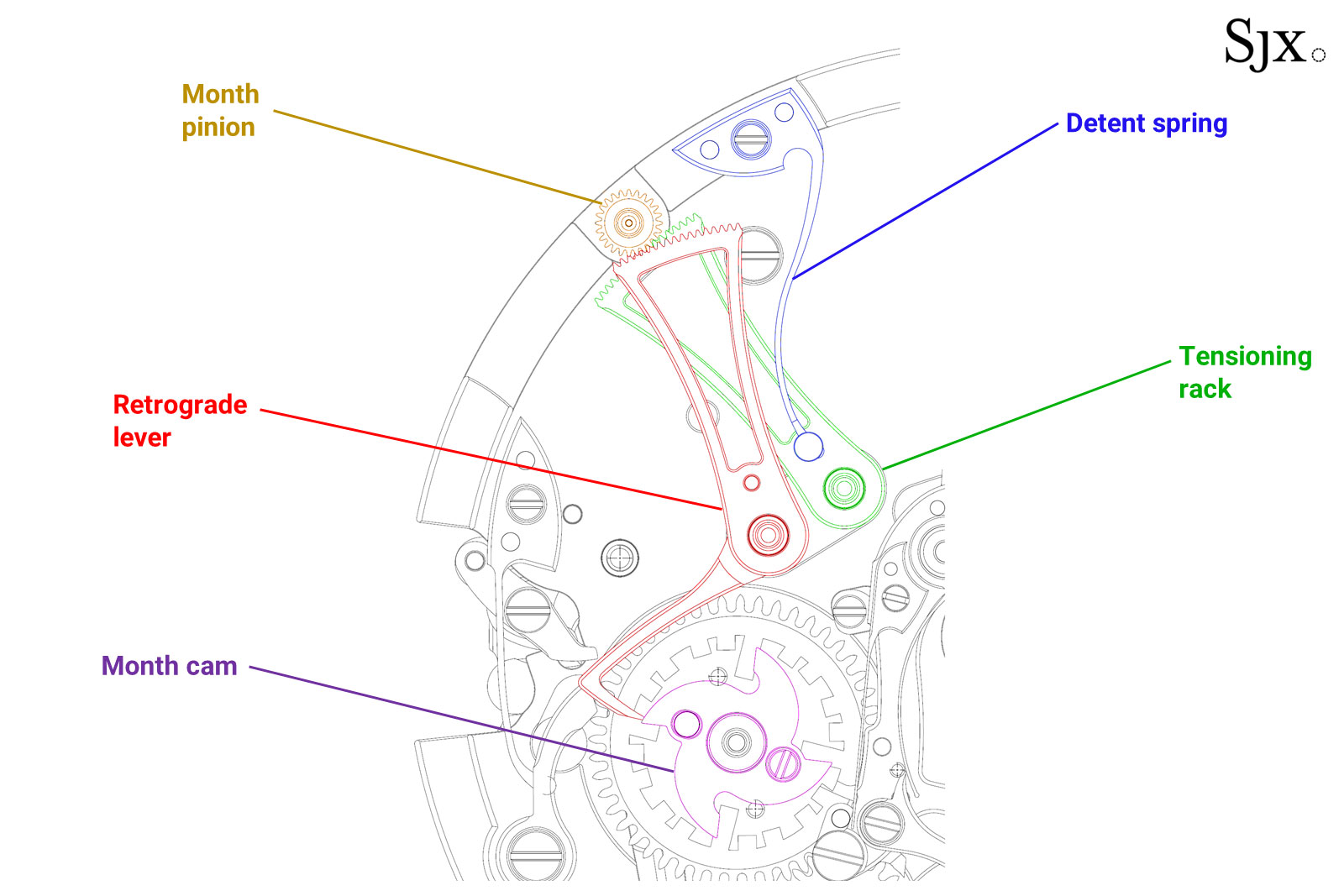
There is a mechanical implication in having the month pinion located right at the edge of the movement. This constraint can be handled in several ways, but Breguet’s approach stands out for being complex and sophisticated.
To ensure a retrograde lever always contacts the cam, the lever has to be tensioned by a spring, which is usually done in one of two ways. The most economical solution is to install a spiral spring onto the month pinion that provides the return force onto the retrograde lever as it winds up from January to December. But because the retrograde display here is on the edge of the movement, there is simply no space to locate a spiral spring onto the month pinion as it will extend beyond the base plate.
Thus, a more expensive solution is required, namely a secondary tensioning rack. The tensioning rack is geared to the month pinion, similar to the retrograde lever. A detent spring applies a force to the tensioning rack, and thus provides the necessary return force to the month pinion, which in turn tensions the retrograde lever. This is a more mechanically elaborate solution compared to the simpler spiral spring, but it allows the month pinion to be located right up to the periphery of the movement in order to achieve the traditional Breguet aesthetic of off-centre displays.
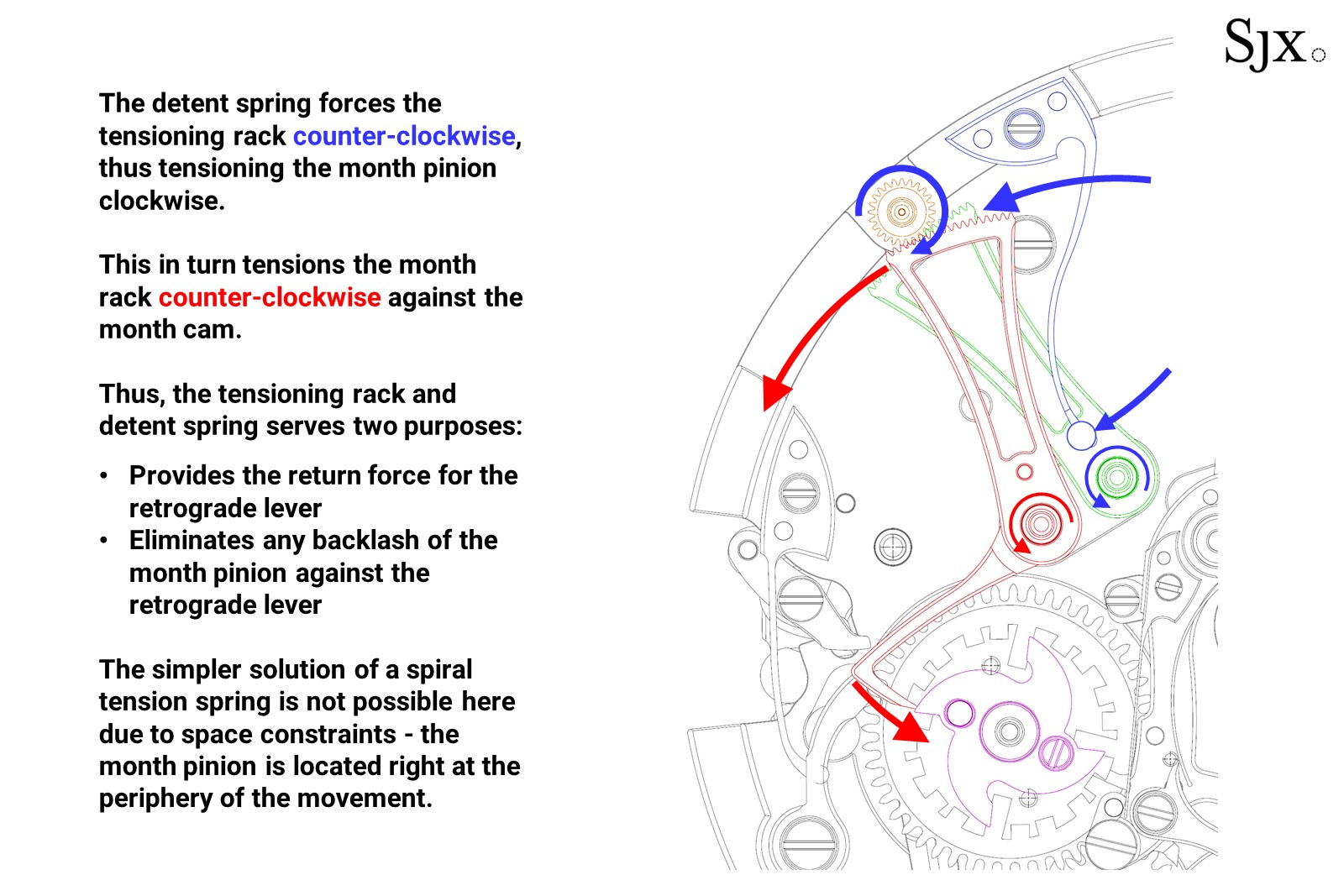
The astute may wonder if the retrograde lever could simply be tensioned by the detent spring directly, and thus foregoing the tension rack. This is not ideal is due to mechanical backlash of the month pinion. If only the retrograde lever is tensioned by the spring, the month pinion will not have any active load tensioning it, and thus it will have some play or backlash between the meshing of its teeth with the retrograde lever rack. This is naturally undesirable for a retrograde display, which demands precision of readings on the small fan-shaped sub dial on the front of the watch.
Thus, by using a tensioning rack, both the month pinion and retrograde lever are always in tension, and therefore there is no longer any mechanical backlash within the system.
Modernised F. Piguet
Under the perpetual calendar mechanise is the cal. 502 derived from the Frederic Piguet cal. 70 introduced in 1970 (which later evolved into the cal. 71). Despite the age of the origin construction, the cal. 502 remains relevant as a high-end movement thanks to its thinness and numerous upgrades such as a silicon hairspring and free-sprung balance.
One of the slimmest automatic movements on the market at its launch in 1970, the calibre is still amongst the thinnest movements on the market five decades later. The entire cal. 502.3.P, including perpetual calendar module, stands only 4.5 mm high, largely thanks to the base calibre measuring only 2.4 mm thick. As a comparison, the Audemars Piguet cal. 7121 found in the Royal Oak “Jumbo” is 3.2 mm high.
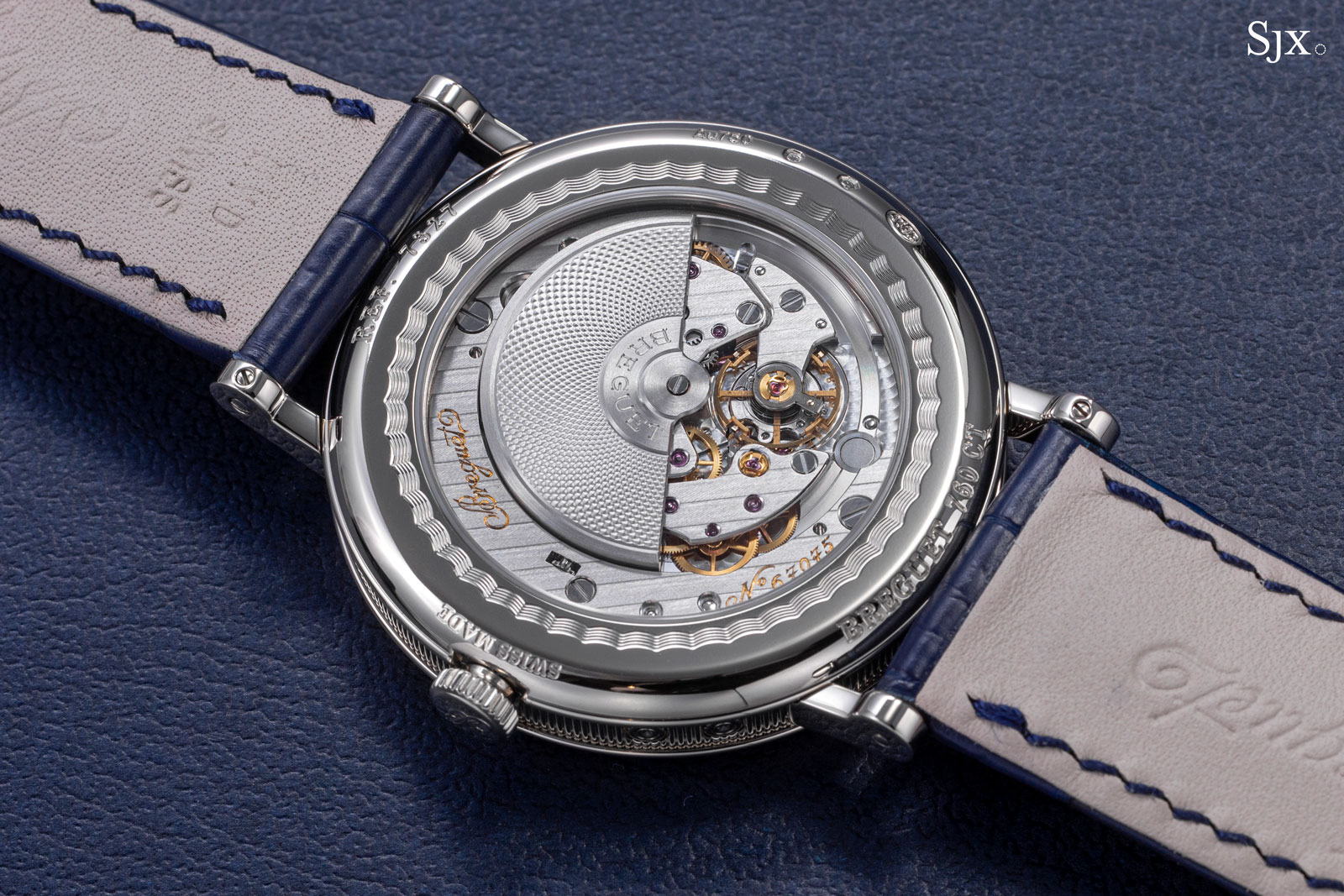
The movement is equipped with a rotor finished with traditional guilloche
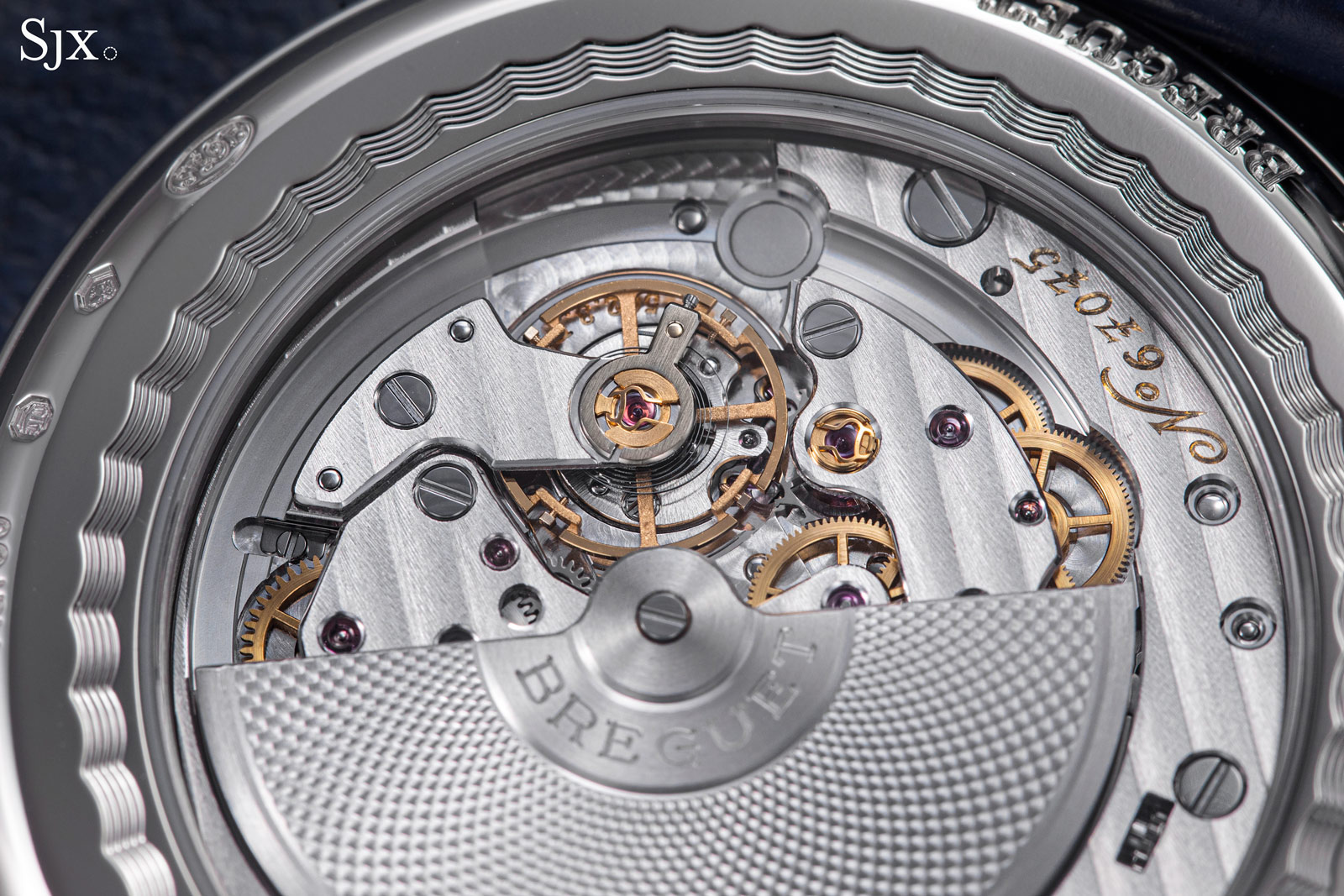
The thinness of the cal. 502 is partly due to its distinctive construction comprising an off-centre rotor that sits in a large recess spanning nearly the entire base plate. The base plate outside the diameter of the rotor effectively creates a crescent-shaped space at the edge of the movement to accommodate components that require height, such as the visible winding pinion of the keyless works.

The base plate is a large, single part with a circular recess to house the offset rotor while a crescent-shaped plateau houses the keyless works.
Another notable quirk of the movement is the open barrel that exposes the mainspring. Doing away with the barrel cover further reduces thickness since the barrel bridge can sit right above the mainspring.
Because the mainspring is visible, it serves as an indirect power reserve indicator since a fully would barrel will have almost all of the mainspring’s coils wound around the centre arbor. This implied power reserve display makes the elimination of the power reserve display on the front a surprisingly logical move.
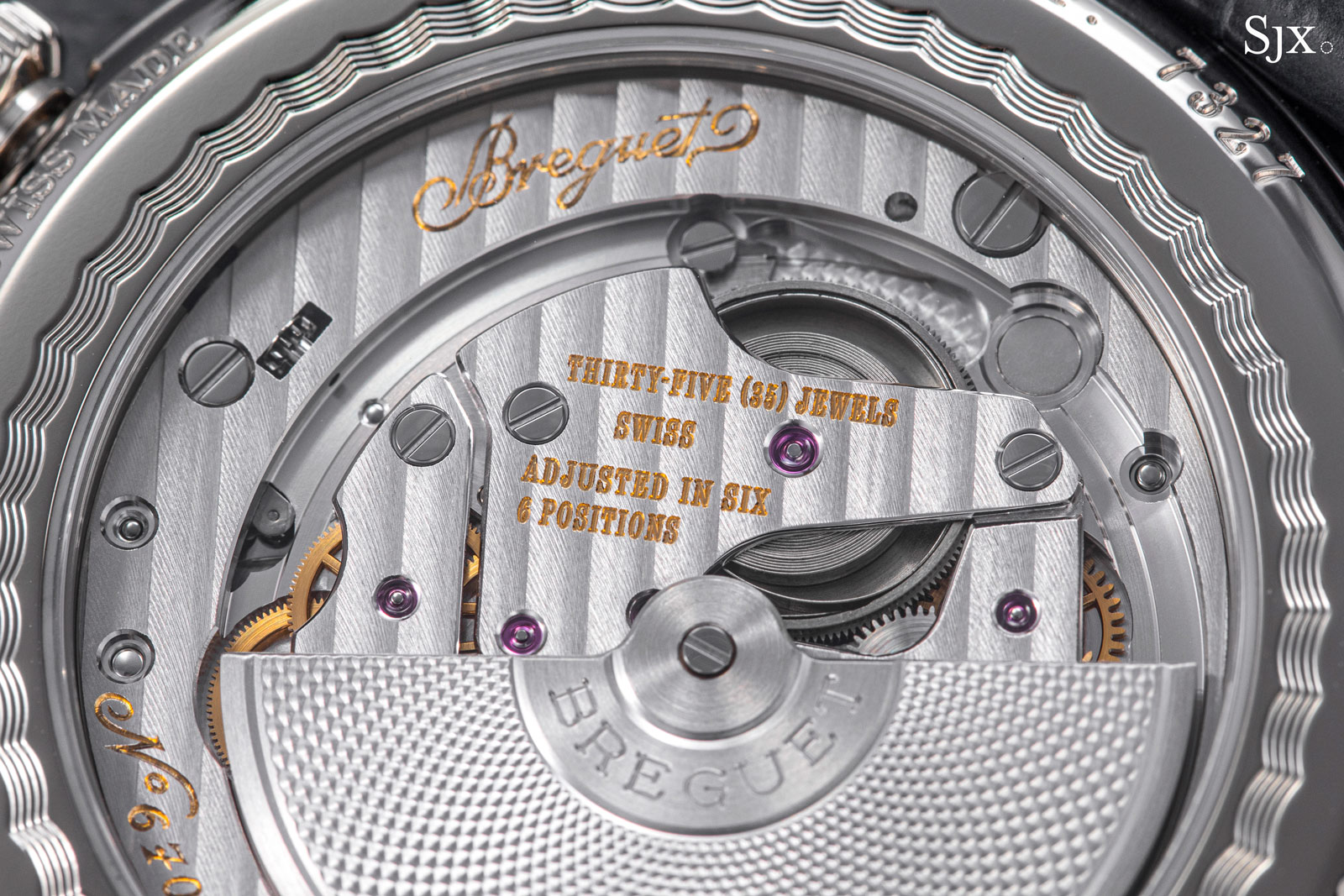
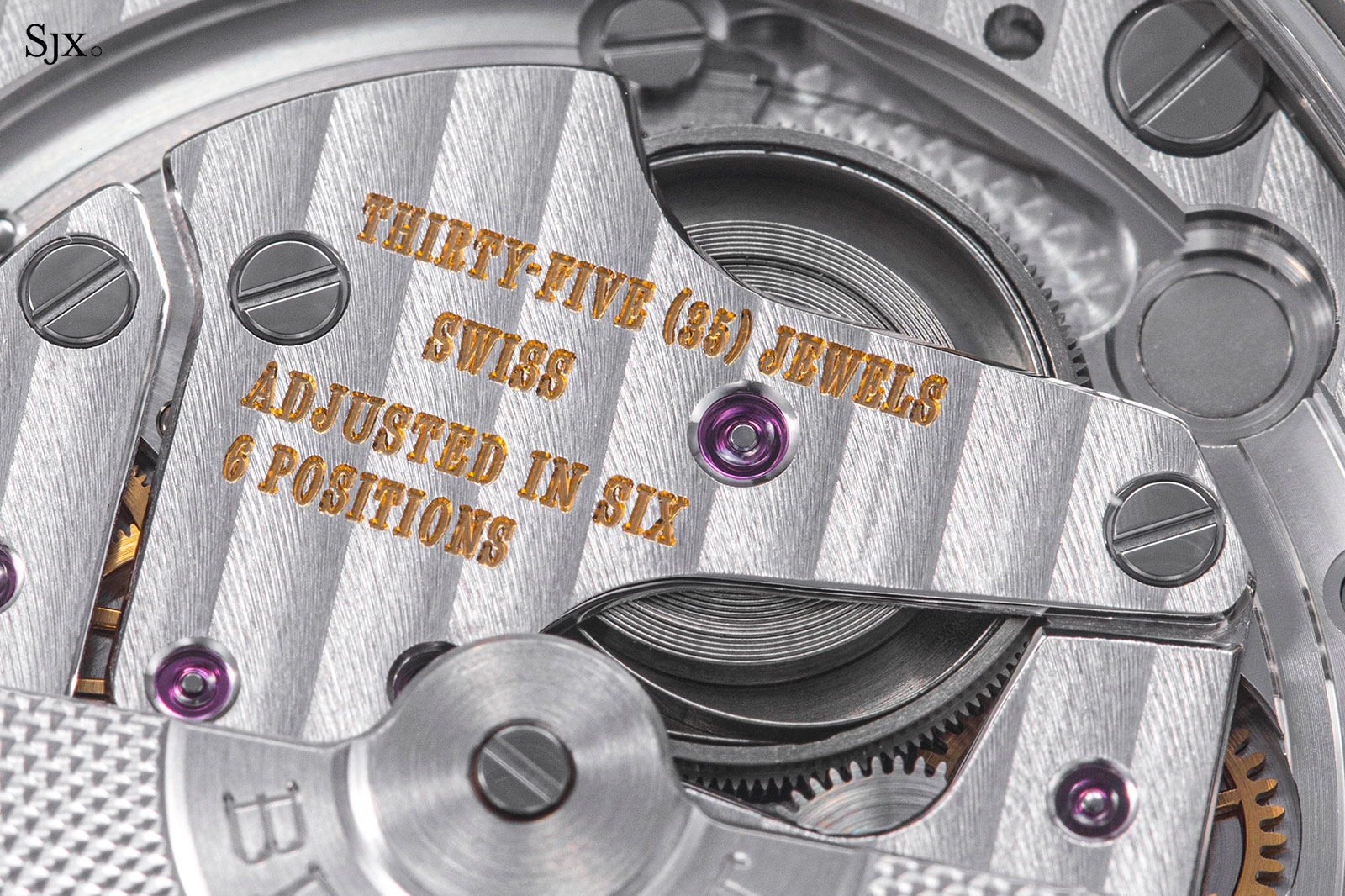
The rest of the movement is mechanically conventional, relatively speaking. The movement has a typical going train for timekeeping, however, the placement of the fourth wheel is not at the traditional six o’clock position, but instead slightly offset from the vertical line of the movement. This means that other watches using the cal. 502, such as the ref. 7147, have the seconds register located at an unusual five o’clock position.
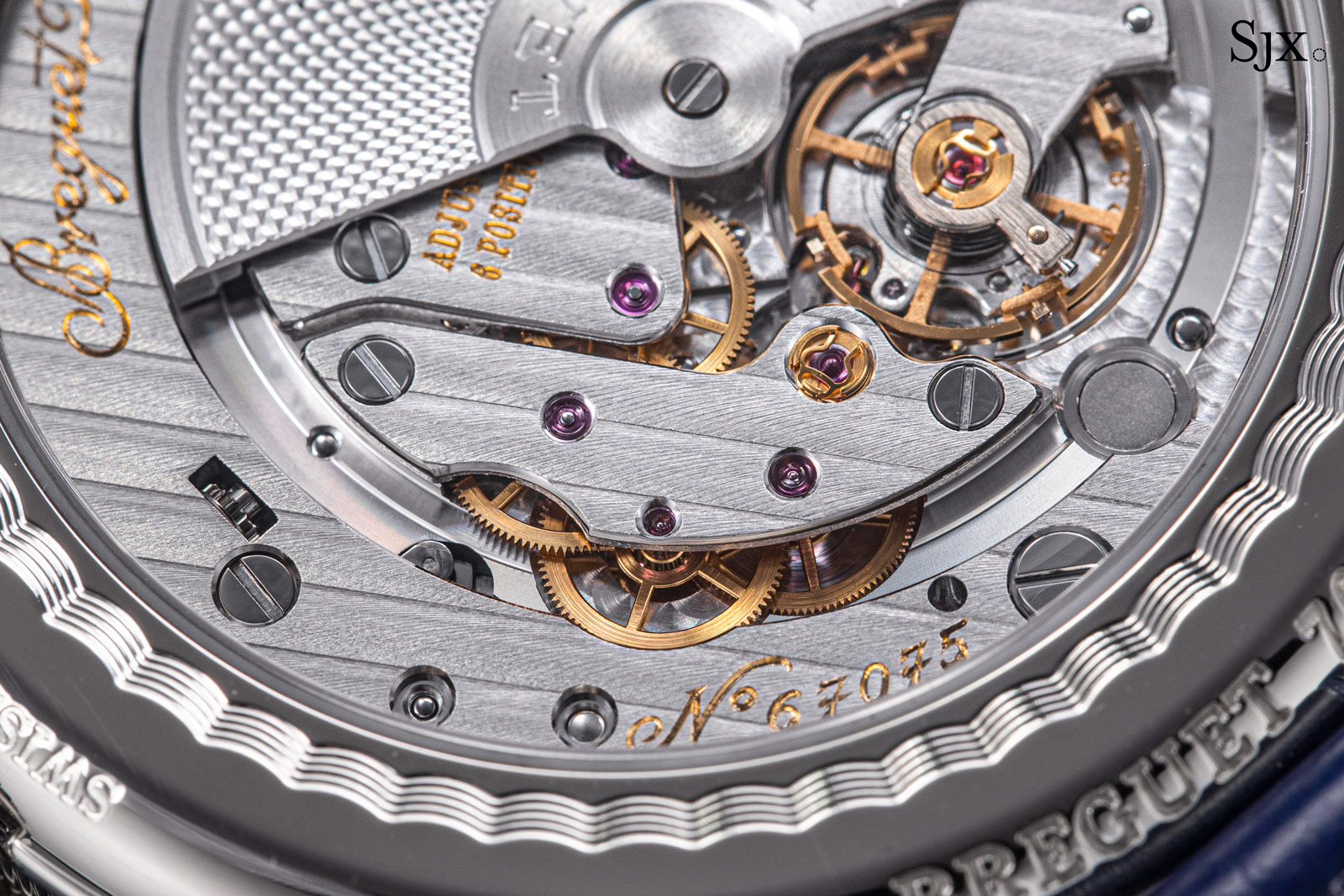
The wheels of the going train visible under the train bridge
Like other older constructions used by Breguet (and its sister companies), the cal. 502.3.P has significant upgrades pertaining to timekeeping – both related to the escapement.
The first is the addition of a free-sprung balance wheel with four inertial weights on recesses along its rim, providing concentric, stable “breathing” of the hairspring.
The second upgrade is more notable from a technological perspective: a silicon hairspring that provides for more stable timekeeping via resistance to magnetism and temperature changes.
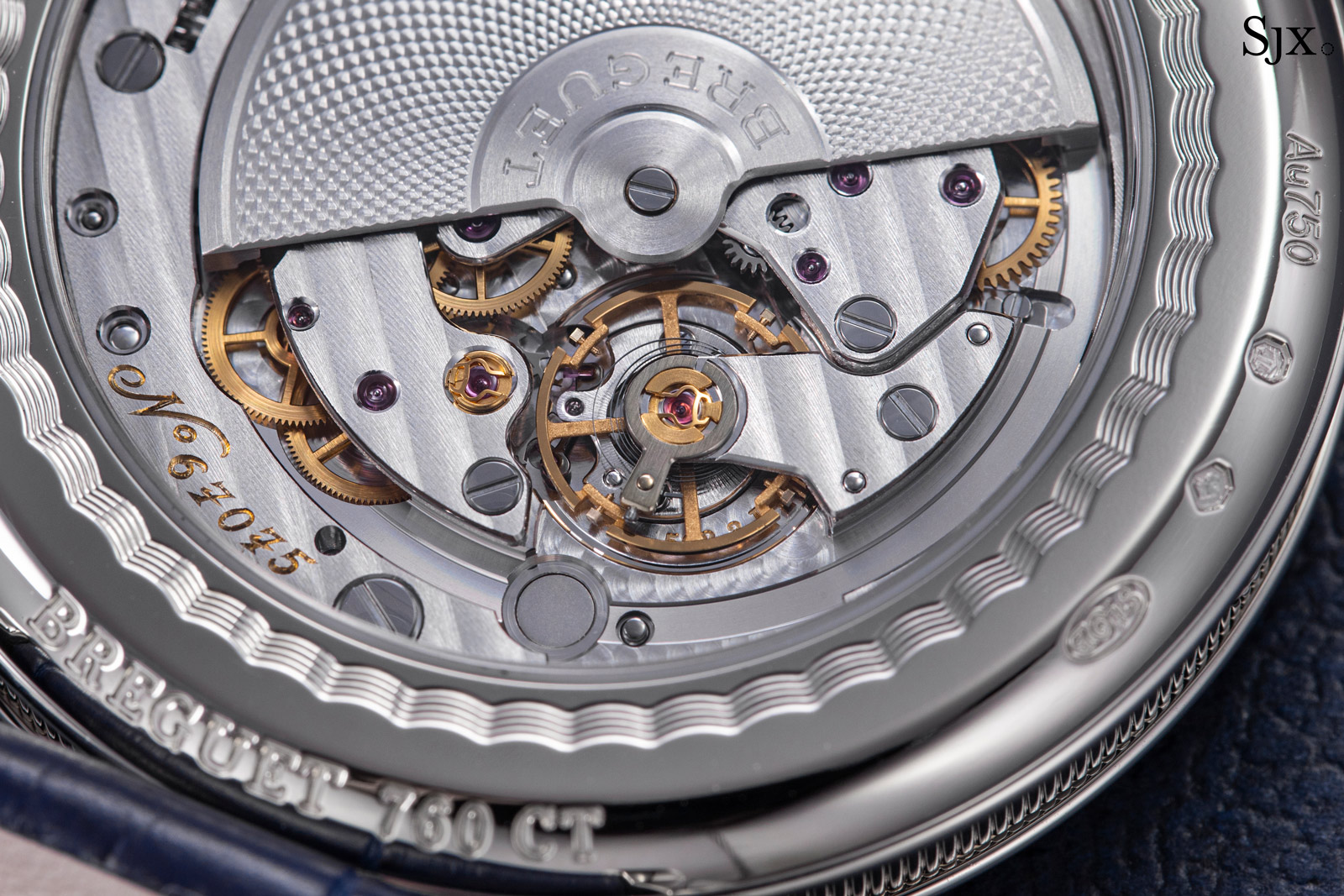
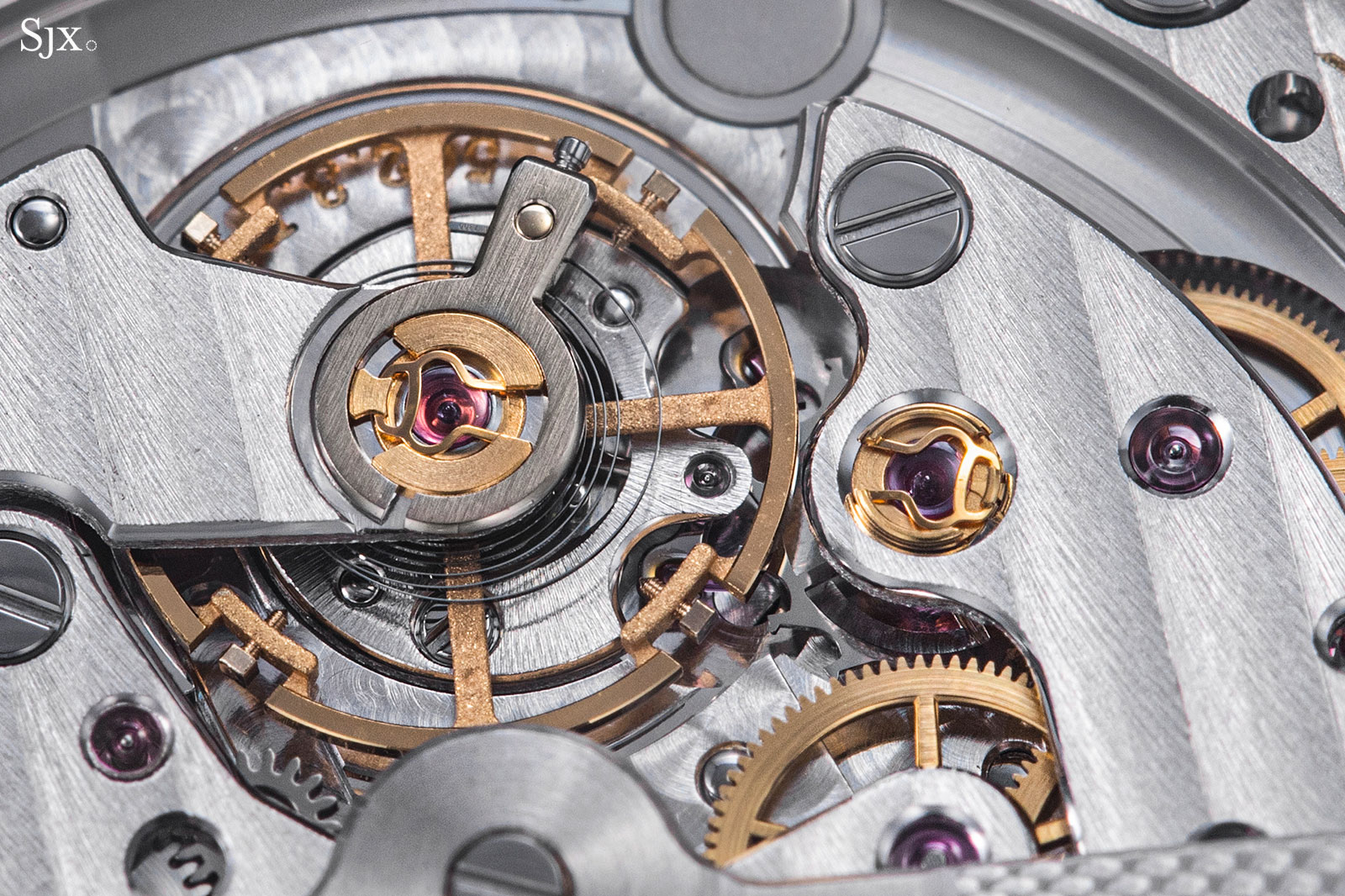
The movement is decorated in a comprehensive, tidy, manner that is comparable to high-end, establishment brands like Patek Philippe and Vacheron Constantin. It combines clean, machined-applied decoration with a touch of hand finishing like anglage on the bridges.
The decoration ticks most checkboxes, including polished and bevelled screw heads, polished countersinks for jewels and screws, and lustrous Cotes de Geneve. Notably, there is no unevenness where the stripes meet the anglage at the edge of the bridges, reflecting the precision of the techniques. Less obvious but perhaps more impressive are the bevelling on the barely-visible pallet lever bridge as well as the domed, polished tops of the locating pins for the bridges.
As for the anglage, now a collector favourite, it is evidently finished by hand with a powered rotary tool that removes machining marks, resulting in a rounded, mirrored finish. However, decoration fanatics will note the bridges lack refinements such as sharp inward or outward angles, which are unfortunately only found on more far expensive watches from established brands or artisanal timepieces from niche makers.
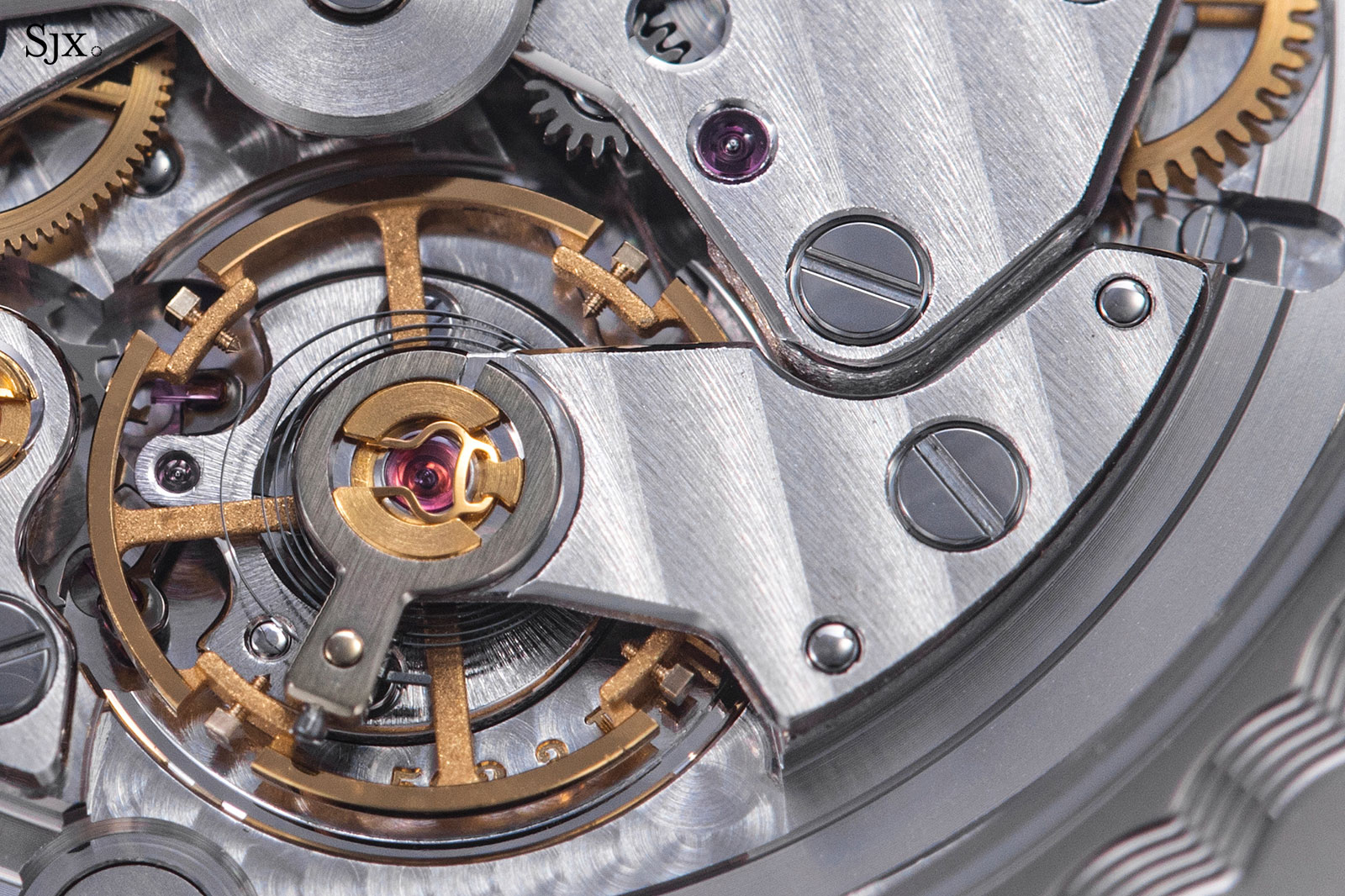
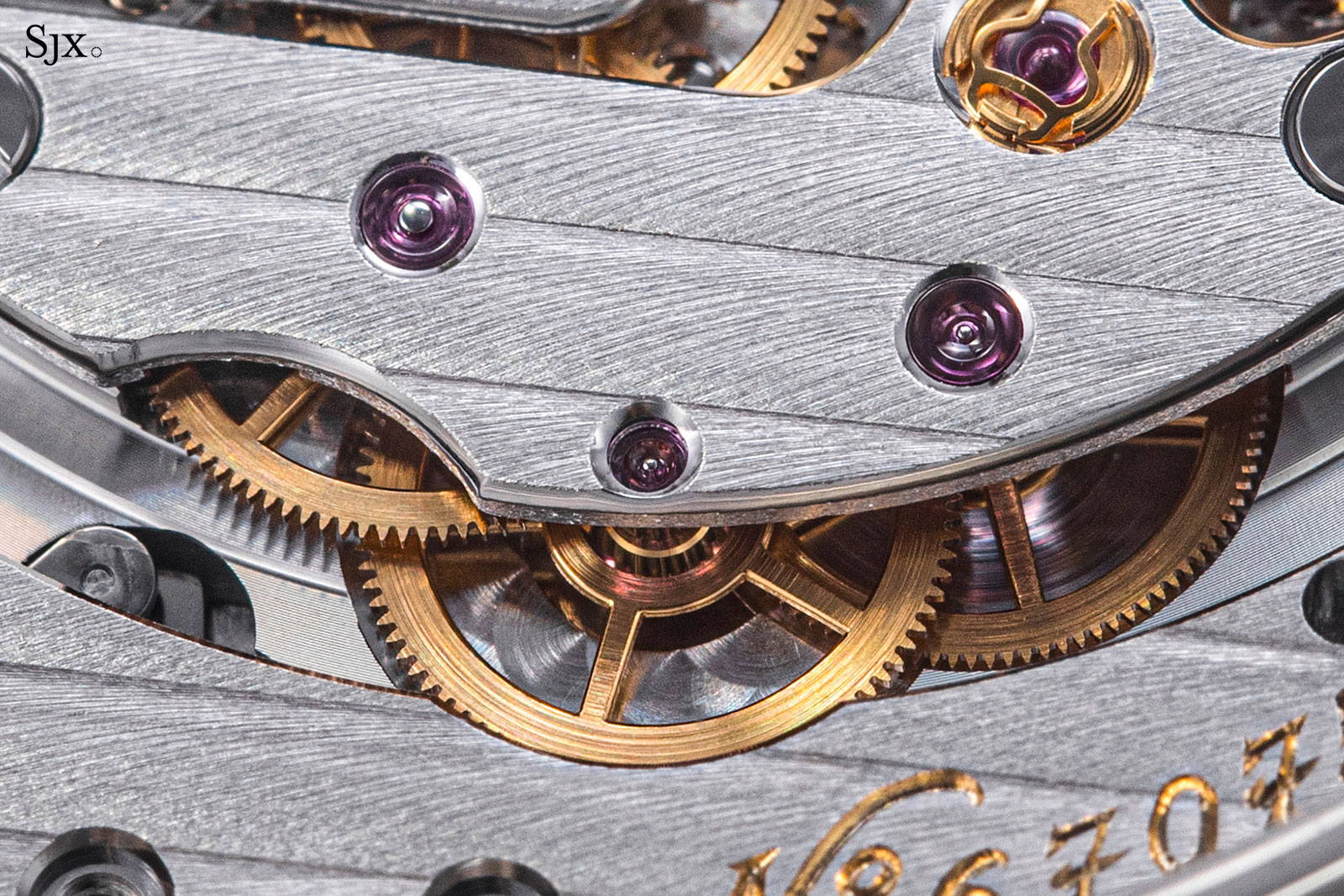
Conclusion
The ref. 7327 benefits from a much-needed facelift that is just right: a traditionally styled timepiece remains traditional but with enough modernity to be relevant. Amongst the best elements of the facelift are the dial that’s even finer but also more contemporary. Granted, the movement remains as traditional as the aesthetic, but it is executed and finished to a high level. For anyone who appreciates the Breguet aesthetic, the ref. 7327 is a compelling proposition.
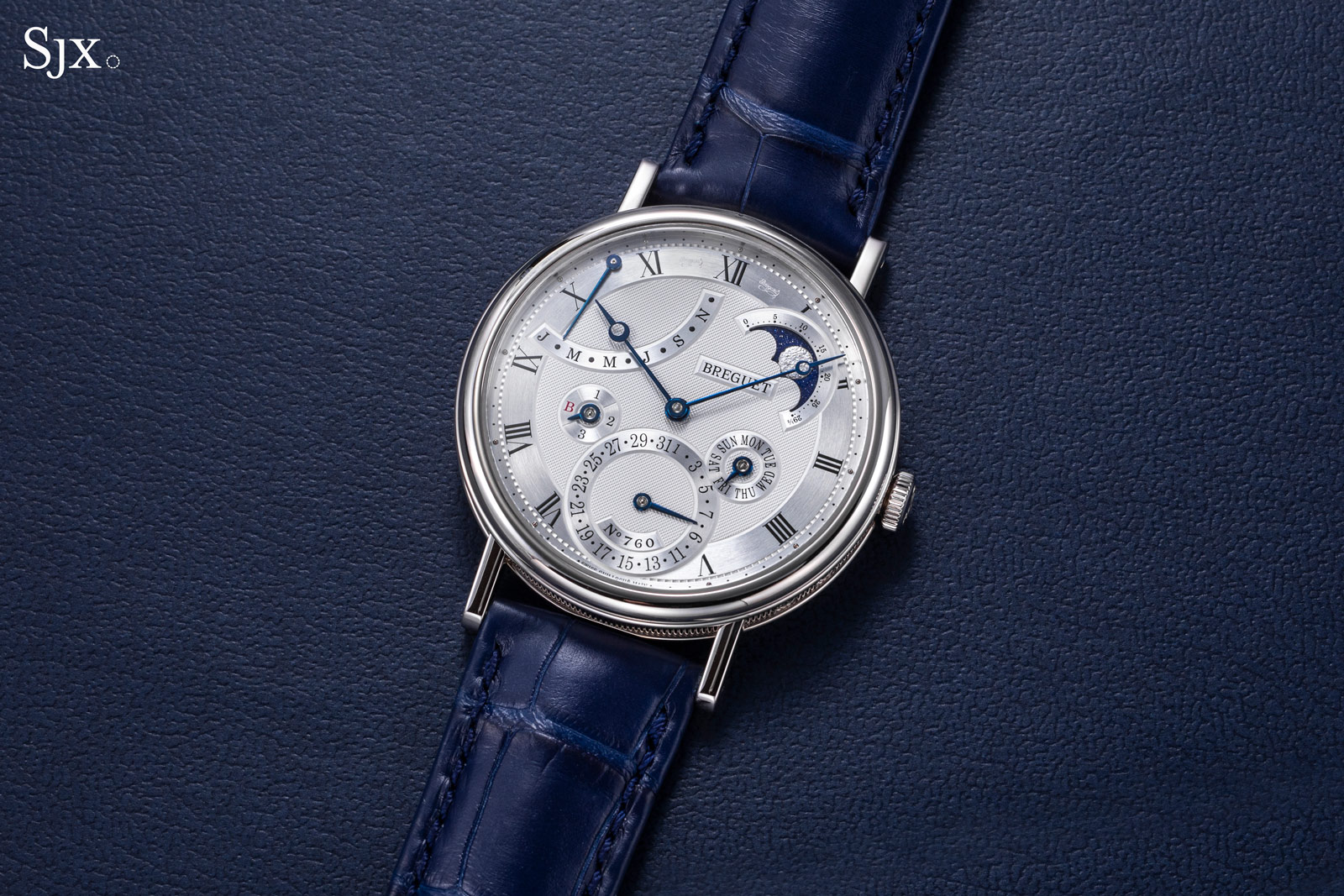
Key facts and price
Breguet Classique Quantième Perpétuel 7327
Ref. 7327BB/11/9VU (white gold)
Ref. 7327BR/11/9VU (rose gold)
Diameter: 39 mm
Height: 9.13 mm
Material: 18K white gold or rose gold
Crystal: Sapphire
Water-resistance: 30 m
Movement: Cal. 502.3.P
Functions: Perpetual calendar with display for the date, day, month, leap year, moon phase, hours, minutes
Winding: Self-winding
Frequency: 21,600 beats per hour (3 Hz)
Power reserve: 45 hours
Strap: Alligator leather with folding clasp
Limited edition: No
Availability: At Breguet boutiques and retailers
Price: CHF 78,300, or 116,300 Singapore dollars
For more, visit Breguet.com.
This was brought to you in partnership with Breguet.
Back to top.

